Catalogue Entry
Citation
Chicago:
Danielle Hampton Cullen, “Camille Pissarro, The Market at Pontoise (or The Market at Gisors), 1895,” catalogue entry in French Paintings and Pastels, 1600–1945: The Collections of The Nelson-Atkins Museum of Art, ed. Aimee Marcereau DeGalan (Kansas City: The Nelson-Atkins Museum of Art, 2023), https://doi.org/10.37764/78973.5.648.5407.
MLA:
Hampton Cullen, Danielle. “Camille Pissarro, The Market at Pontoise (or The Market at Gisors), 1895,” catalogue entry. French Paintings and Pastels, 1600–1945: The Collections of The Nelson-Atkins Museum of Art, edited by Aimee Marcereau DeGalan, Nelson-Atkins Museum of Art, 2023. doi: 10.37764/78973.5.648.5407.
While a wealth of scholarship has been devoted to Camille Pissarro’s landscapes, very little has been written about the artist’s interest in the rural marketplace.1See, for example, Richard R. Brettell and Joachim Pissarro, The Impressionist and the City: Pissarro’s Series Paintings, ed. MaryAnne Stevens, exh. cat. (New Haven: Yale University Press, 1992); and Katherine Rothkopf, Pissarro: Creating the Impressionist Landscape, exh. cat. (London: Phillips Wilson, 2006). For contributions made on the reappraisal of Pissarro’s rural subject matter, see Richard R. Brettell, Pissarro’s People, exh. cat. (San Francisco: Fine Arts Museums of San Francisco, 2012); and Christopher Lloyd, “The Market Scenes of Camille Pissarro,” Art Bulletin of Victoria, no. 25 (1985): 17–32. Although the French countryside remained the subject of many of Pissarro’s finest compositions, the artist became increasingly dissatisfied with this SalonSalon, the: Exhibitions organized by the French Royal Academy of Painting and Sculpture (Académie Royale de Peinture et de Sculpture) and its successor the Academy of Fine Arts (Académie des Beaux Arts), which took place in Paris from 1667 onward.-approved motif during the 1880s.2In a letter to his friend and art dealer Paul Durand-Ruel in 1885, the artist wrote: “I have not been able to finish certain fairly curious and above all very difficult subjects . . . please believe that this is a cause of great anxiety for me; it is, clearly, a crisis.” Camille Pissarro to Paul Durand-Ruel, June/July 1885, in Janine Bailly-Herzberg, Correspondance de Camille Pissarro (Paris: Presses Universitaires de France, 1980), 1:336. By the Seventh Impressionist exhibition in 1882, he found new subject matter in the rural marketplace. Pissarro was delighted with the endless source of inspiration and pictorial renewal it offered him, and it became a mainstay of his work until his death in 1903.3Of the thirty-six works exhibited by Pissarro at the 1882 Impressionist exhibition, more than half dealt with the subject of rural workers; of those works, more than a dozen belonged to a series of market scenes from Pontoise. For Pissarro, the Seventh Impressionist Exhibition provided a platform to unveil new aspects of his work; see Catalogue de la 7ème Exposition de Peinture, exh. cat. (Paris: Rue Le Peletier, 1881), unpaginated, repr., in Theodore Reff, ed., Modern Art in Paris: Two-Hundred Catalogues of the Major Exhibitions Reproduced in Facsimile in Forty-Seven Volumes, vol. 23, Impressionist Group Exhibitions (New York: Garland, 1981), unpaginated. The Market at Pontoise (or The Market at Gisors) is among the half-dozen or so oil paintings Pissarro produced during the most experimental years of his practice, the 1880s through the early 1890s, that made a lasting contribution to the representation of rural imagery. In them, Pissarro treated the rural marketplace as a modern setting.4Pissarro created his first market scenes in 1881. See Ludovico Rodo Pissarro and Lionello Venturi, Camille Pissarro, Son art, Son Œuvre (Paris: Paul Rosenberg, 1939), nos. 1346–48, pp. 1:267–68. Pissarro was particularily fond of rendering his market scenes in pencil and gouache. His first oil painting of a rural market was not created until 1882. See Joachim Pissarro and Claire Durand-Ruel Snollaerts, Pissarro: Catalogue critique des peintures; Critical Catalogue of Paintings (Milan: Skira Editore, 2005), no. 682, p. 2:456, as Le Marché à la volaille, Pontoise (The Poultry Market, Pontoise).
In December of 1883, Pissarro and his family moved away from Pontoise, where they had lived for almost a decade, finally settling near the market town of Gisors in 1884. During these years, Pissarro mingled with rural marketgoers, cultivating a profound sense of intimacy in his work, which was a pronounced departure from the conventional standards of peasant imagery. His market scenes were specific to the locale, and the working men and women were part of the modern landscape. Like Pontoise, where Pissarro had lived for much of his life, Gisors relied almost entirely on an unregulated, self-sustained market in which producers bartered over the exchange of goods and services. Pissarro was an avid reader of liberal politics, and this concept of “economic anarchism” must have appealed to him. Indeed, Pissarro’s association with left-wing politics often pervades the understanding of the artist’s profound contribution to the representation of rural labor within modern art, with many scholars comparing his rural market scenes to his political ideologies.5This concept of an independent market economy was readily adopted by Pissarro through the literature of Peter Kropotkin, Élisée Reclus, and Jean Grave. For a detailed monograph on Pissarro’s affiliation to left-wing politics in relation to his art, see Brettell, Pissarro’s People, 219–31. However, if Pissarro simply created his market scenes as a form of “pictorial anarchism,” as many scholars believe, his work might resemble that of Jean-François Millet (1814–1875), who had developed a “plight of the peasant” trope decades earlier.6For the “plight of the peasant” trope depicted by Millet, see Chanel Georgel, Millet (Paris: Citadelles et Mazenod, 2014); and Alexandra R. Murphy, Jean-François Millet: Drawn into the Light (New Haven: Yale University Press, 1999). Instead, Pissarro’s marketgoers busily go about their daily life, negotiating, gossiping, and conversing in a modern rural setting. In the same way that the fashionable streets of Paris were depicted decades earlier by his contemporary Claude Monet (1840–1926), Pissarro painted a natural complement in the market stalls of a busy, rural gathering place as the social and economic center of its community.
The Market at Pontoise (or The Market at Gisors) reflects the artistic challenges that Pissarro embraced during this time in his career. Pissarro welcomed the opportunity to not only study the subject of the urban marketplace but also to represent it in modern ways. The art critic Théodore Duret, a friend of Pissarro’s, explained the artist’s indifference to conventional standards of rural imagery in 1906, writing: “[Pissarro’s] peasants, in particular, have none of that superimposed grandeur with which Millet, still in part under the influence of his time, never failed to endow them.”7“Ses paysans se présentent donc, sans cette part de grandeur superposée que Millet pénétré, pour un reste, de l’esprit de son temps, n’avait pu manquer de rechercher.” Théodore Duret, Histoire des peintres impressionnistes (Paris: H. Floury, 1906), 68. All translations are by the author unless otherwise noted. Writing to his son Lucien Pissarro (1863–1944) in May 1887, Pissarro exclaimed of Millet, “he was just a bit too biblical. Another one of those blind men, leaders or followers, who, unconscious of the march of modern ideas, defend the idea without knowing it, despite themselves!”8Camille Pissarro to Lucien Pissarro, May 2, 1887, in John Rewald and Lucien Pissarro, eds., Camille Pissarro, Letters to His Son Lucien, trans. Lionel Abel (Boston: MFA Publications, 2002), 105–06. A longtime resident of market towns, the artist portrayed his subjects not as weary workers but as contemporary French men and women, an approach that was central to his artistic concerns. Considering Pissarro’s market scenes in terms of their modernity, instead of as a form of political anarchism or in the context of a presumed association with Millet, opens his work up to richer interpretation. Such distinctions prompt one to examine more closely the aesthetic and compositional devices significant in Pissarro’s later market scenes.
By the mid-1880s, Pissarro adopted pointillismpointillism: A technique of painting using tiny dots of pure colors, which when seen from a distance are blended by the viewer’s eye. It was developed by French Neo-Impressionist painters in the mid-1880s as a means of producing luminous effects., a scientific method of painting with tiny dots of color pioneered by the young artist Georges Seurat (1859–1891) in works such as Study for “Bathers at Asnières” and Study for “The Channel of Gravelines, Petit Fort Philippe”. Pissarro would have seen Seurat’s technique in A Sunday on La Grande Jatte—1884 (1884; Art Institute of Chicago) when it was first exhibited alongside his own work at the eighth and final Impressionist Exhibition in 1886.9See Catalogue de la 8^me^ Exposition de Peinture, exh. cat. (Paris: Rue Le Peletier, 1886), unpaginated, repr., in Reff, Modern Art in Paris, vol. 23, as Un Dimanche à la Grande-Jatte. Pissarro undoubtedly would have been aware of this painting, as he himself exhibited at the 1886 exhibition and would come to vehemently defend the work of Seurat and his pointillist technique following the 1886 exhibition. See letters from Camille Pissarro to Lucien Pissarro from 1886 in Rewald and Pissarro, Letters, 73, 77, 88, 90. Although Pissarro began to move away from the pointillist style by the 1890s, the variety of short, fragmented marks in the Kansas City canvas suggests the lasting impact that Seurat’s technique had on Pissarro. While markedly more subdued than Seurat’s aforementioned masterpiece in terms of brushwork, the Nelson-Atkins painting is a significant example of Pissarro’s long-standing appreciation for the scientific technique.
In the Nelson-Atkins painting, a small cluster of women, two standing and one seated, occupy the immediate foreground, in close proximity to the viewer.10For the lithograph of the same subject, see Loys Delteil, Camille Pissarro: l’Œuvre gravé et lithographié (San Francisco: Alan Wofsy Fine Arts, 1999), no. 147, pp. 316–17, as Marché à Pontoise (Market at Pontoise). The vertical format of the painting offers a close study of human activity, in contrast to the less populated horizontal landscapes Pissarro created almost a decade earlier. Whereas in his earlier market scenes, the artist set his marketgoers amid a horizontal band of vegetation (see, for example, Horse Market, Saint-Martin Fair, Pontoise, 1883, private collection, France), the vertical format in The Market at Pontoise (or The Market at Gisors) exemplifies his new, innovative pictorial approach to composition.11Pissarro and Venturi, Camille Pissarro, no. 1372, pp. 1:271. The art historian Joachim Pissarro, Pissarro’s great-grandson, has written extensively on the artist’s profound sense of modernity in adopting this compositional device into his market scenes.12For more on Joachim Pissarro’s interpretation of his great-grandfather’s market scenes, see Joachim Pissarro, Camille Pissarro (New York: Abrams, 1993), 198–99. This transition from a horizontal composition to a vertical one acted as the foundation for the artist’s construction of a modern space in many of his later market scenes. In the case of the Nelson-Atkins painting, the fragmented, vertical format provides a sense of a dense crowd of which the viewer is a part. The innumerable marketgoers interact in the background just as the women do in the foreground, further adding to the sense of heightened social exchange.
Indeed, Pissarro’s conscious decision to fragment the market in the background has made it difficult to discern the specific location of this work. This may account for the persistent vacillation between titles of the Nelson-Atkins painting, associating the market scene with both Pontoise and Gisors. Current research reveals that the Nelson-Atkins painting was first exhibited in 1903 at the Exposition des Beaux-Arts in Mâcon, France, under what presumably would have been Pissarro’s own title: Pontoise (le marché).13Exposition des Beaux-Arts, exh. cat. (Mâcon: Buguet-Comptour, 1903), 69. The 1903 exhibition included the Impressionist and Post-Impressionist art collection of André Teissier, a friend and notary to Pissarro.14“L’exposition des beaux-arts qui vient de se clore s’est particularisée par la présence, assez inattendue dans une exposition de province, des maîtres impressionnistes et néo-impressionnistes: Camille Pissarro, H.-E. Cross, Signac, Luce, Van Rysselberghe . . . et une section spécial était constituée par la collection très précieuse de M. André Teissier.” (The fine arts exhibition, which has just ended, was characterized by the presence, quite unexpected in a provincial exhibition, of Impressionist and Neo-Impressionist masters: Camille Pissarro, H.-E. Cross, Signac, Luce, Van Rysselberghe . . . and a special section was devoted to the very precious collection of Mr. André Teissier). Argus, “Dans les départements et a l’étranger,” Le Figaro 49, no. 238 (August 26, 1903): 4. Because Teissier acquired the painting directly from the artist by 1900, it further seems likely that the painting’s exhibition title came from Pissarro. As early as 1921, the painting was retitled Marché de Gisors for an exhibition at The Goupil Gallery in London.15The Second Exhibition of Works by Members of the Monarro Group, exh. cat. (London: Goupil Gallery, 1921), 7. Several years later, the painting would be retitled by C. W. Kraushaar Galleries, New York, on the basis of an annotated lithograph of the same subject titled The Market at Pontoise (Fig. 1).16See Catalogue of an Exhibition of French Paintings and Sculpture from the Kraushaar Galleries, New York, and Private Collections (Toronto: Art Gallery of Toronto, 1929), 5–6. The work goes back and forth between both titles throughout its bibliographic and exhibition history. Recently, several scholars have argued in favor of and adopted the title Le Marche à Gisors; see Claire Durand-Ruel Snollaerts and Christophe Duvivier, Camille Pissarro: Le premier des impressionnistes, exh. cat. (Paris: Éditions Hazan, 2017), 108–09, 203, 206; and Christophe Duvivier and Michel Melot, Camille Pissarro: Impressions gravées, exh. cat. (Paris: Somogy, 2017), 84. Until recently, the Nelson-Atkins Museum of Art titled the painting Market at Pontoise.
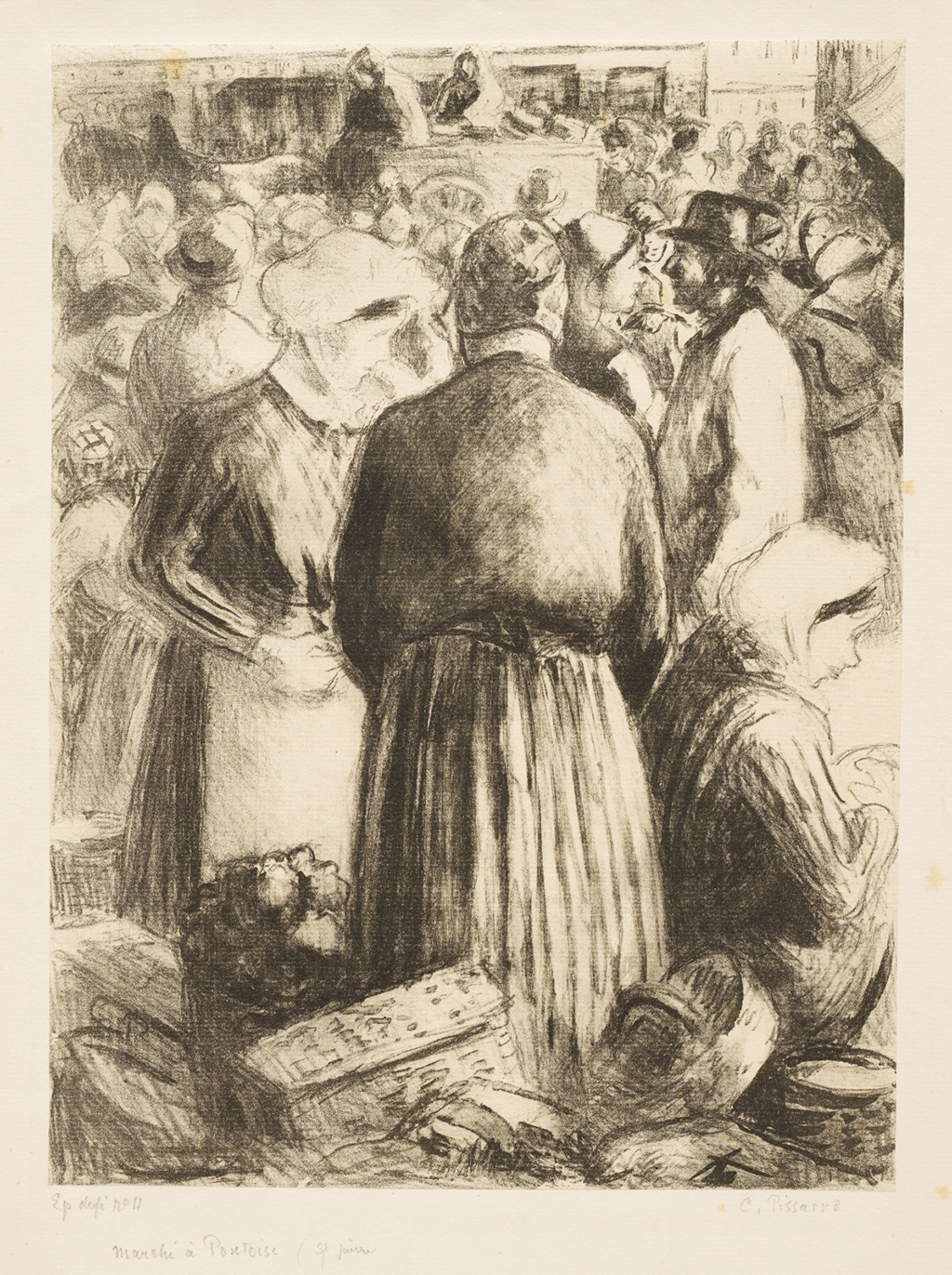 Fig. 1. Camille Pissarro, The Market at Pontoise, ca. 1895, lithograph on paper, image: 11 7/8 x 8 11/16 in. (30.1 x 22.1 cm); sheet: 17 11/16 x 12 5/16 in. (45 x 31.2 cm), Sterling and Francine Clark Art Institute, Williamstown, MA, 1962.95
Fig. 1. Camille Pissarro, The Market at Pontoise, ca. 1895, lithograph on paper, image: 11 7/8 x 8 11/16 in. (30.1 x 22.1 cm); sheet: 17 11/16 x 12 5/16 in. (45 x 31.2 cm), Sterling and Francine Clark Art Institute, Williamstown, MA, 1962.95
 Fig. 2. Camille Pissarro, Poultry Market at Gisors, 1885, tempera and pastel on paper mounted on wood, 32 3/8 x 32 3/8 in. (82.2 x 82.2 cm), Museum of Fine Arts, Boston, Bequest of John T. Spaulding, 48.588
Fig. 2. Camille Pissarro, Poultry Market at Gisors, 1885, tempera and pastel on paper mounted on wood, 32 3/8 x 32 3/8 in. (82.2 x 82.2 cm), Museum of Fine Arts, Boston, Bequest of John T. Spaulding, 48.588
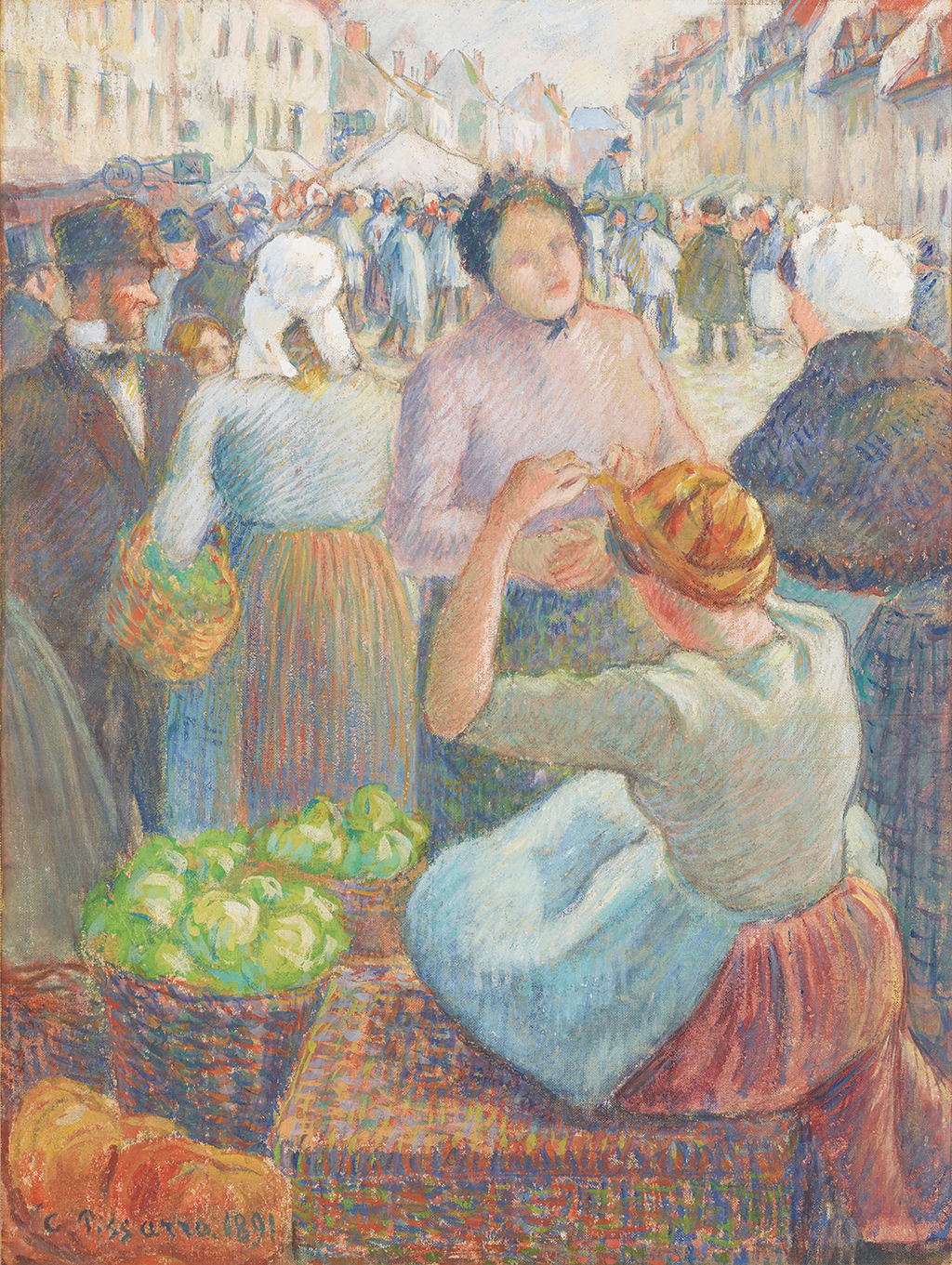 Fig. 3. Camille Pissarro, The Marketplace, Gisors, 1891, opaque watercolor with black conté crayon over traces of charcoal on fabric mounted to thin cardboard, sheet: 14 x 10 1/4 in. (35.6 x 26 cm), Philadelphia Museum of Art, The Louis E. Stern Collection, 1963, 1963-181-55. Photo: The Philadelphia Museum of Art / Art Resource, NY
Fig. 3. Camille Pissarro, The Marketplace, Gisors, 1891, opaque watercolor with black conté crayon over traces of charcoal on fabric mounted to thin cardboard, sheet: 14 x 10 1/4 in. (35.6 x 26 cm), Philadelphia Museum of Art, The Louis E. Stern Collection, 1963, 1963-181-55. Photo: The Philadelphia Museum of Art / Art Resource, NY
 Fig. 4. Camille Pissarro, The Market at Gisors (Rue Cappeville), ca. 1894, etching, drypoint, and burnisher, printed in color, plate: 7 3/4 x 5 1/2 in. (19.8 x 14.1 cm.); sheet: 11 x 8 1/2 in. (26.9 x 19.8 cm), Ashmolean Museum, University of Oxford, England. Presented by Miss Orovida Pissarro, WA1953.88.2
Fig. 4. Camille Pissarro, The Market at Gisors (Rue Cappeville), ca. 1894, etching, drypoint, and burnisher, printed in color, plate: 7 3/4 x 5 1/2 in. (19.8 x 14.1 cm.); sheet: 11 x 8 1/2 in. (26.9 x 19.8 cm), Ashmolean Museum, University of Oxford, England. Presented by Miss Orovida Pissarro, WA1953.88.2
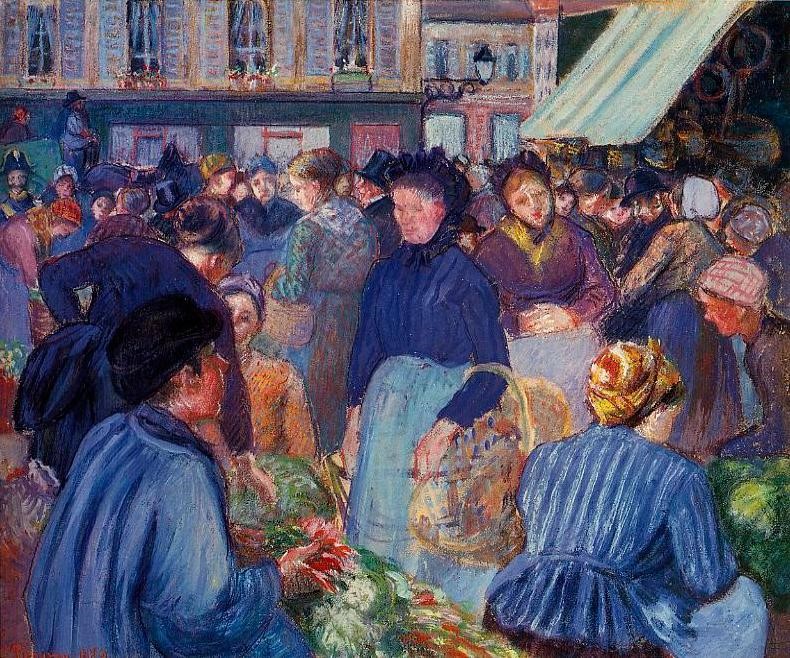
Notes
-
See, for example, Richard R. Brettell and Joachim Pissarro, The Impressionist and the City: Pissarro’s Series Paintings, ed. MaryAnne Stevens, exh. cat. (New Haven: Yale University Press, 1992); and Katherine Rothkopf, Pissarro: Creating the Impressionist Landscape, exh. cat. (London: Phillips Wilson, 2006). For contributions made on the reappraisal of Pissarro’s rural subject matter, see Richard R. Brettell, Pissarro’s People, exh. cat. (San Francisco: Fine Arts Museums of San Francisco, 2012); and Christopher Lloyd, “The Market Scenes of Camille Pissarro,” Art Bulletin of Victoria, no. 25 (1985): 17–32.
-
In a letter to his friend and art dealer Paul Durand-Ruel in 1885, the artist wrote: “I have not been able to finish certain fairly curious and above all very difficult subjects . . . please believe that this is a cause of great anxiety for me; it is, clearly, a crisis.” Camille Pissarro to Paul Durand-Ruel, June/July 1885, in Janine Bailly-Herzberg, Correspondance de Camille Pissarro (Paris: Presses Universitaires de France, 1980), 1:336.
-
Of the thirty-six works exhibited by Pissarro at the 1882 Impressionist exhibition, more than half dealt with the subject of rural workers; of those works, more than a dozen belonged to a series of market scenes from Pontoise. For Pissarro, the Seventh Impressionist Exhibition provided a platform to unveil new aspects of his work; see Catalogue de la 7ème Exposition de Peinture, exh. cat. (Paris: Rue Le Peletier, 1882), unpaginated, repr., in Theodore Reff, ed., Modern Art in Paris: Two-Hundred Catalogues of the Major Exhibitions Reproduced in Facsimile in Forty-Seven Volumes, vol. 23, Impressionist Group Exhibitions (New York: Garland, 1981), unpaginated.
-
Pissarro created his first market scenes in 1881. See Ludovico Rodo Pissarro and Lionello Venturi, Camille Pissarro, Son art, Son Œuvre (Paris: Paul Rosenberg, 1939), nos. 1346–48, pp. 1:267–68. Pissarro was particularily fond of rendering his market scenes in pencil and gouache. His first oil painting of a rural market was not created until 1882. See Joachim Pissarro and Claire Durand-Ruel Snollaerts, Pissarro: Catalogue critique des peintures; Critical Catalogue of Paintings (Milan: Skira Editore, 2005), no. 682, p. 2:456, as Le Marché à la volaille, Pontoise (The Poultry Market, Pontoise).
-
This concept of an independent market economy was readily adopted by Pissarro through the literature of Peter Kropotkin, Élisée Reclus, and Jean Grave. For a detailed account of Pissarro’s affiliation with left-wing politics in relation to his art, see Brettell, Pissarro’s People, 219–31.
-
For the “plight of the peasant” trope depicted by Millet, see Chanel Georgel, Millet (Paris: Citadelles et Mazenod, 2014); and Alexandra R. Murphy, Jean-François Millet: Drawn into the Light (New Haven: Yale University Press, 1999).
-
“Ses paysans se présentent donc, sans cette part de grandeur superposée que Millet pénétré, pour un reste, de l’esprit de son temps, n’avait pu manquer de rechercher.” Théodore Duret, Histoire des peintres impressionnistes (Paris: H. Floury, 1906), 68. All translations are by the author unless otherwise noted.
-
Camille Pissarro to Lucien Pissarro, May 2, 1887, in John Rewald and Lucien Pissarro, eds., Camille Pissarro, Letters to His Son Lucien, trans. Lionel Abel (Boston: MFA Publications, 2002), 105–06.
-
See Catalogue de la 8me Exposition de Peinture, exh. cat. (Paris: Rue Le Peletier, 1886), unpaginated, repr., in Reff, Modern Art in Paris, vol. 23, as Un Dimanche à la Grande-Jatte. Pissarro undoubtedly would have been aware of this painting, as he himself exhibited at the 1886 exhibition and would come to vehemently defend the work of Seurat and his pointillist technique following the 1886 exhibition. See letters from Camille Pissarro to Lucien Pissarro from 1886 in Rewald and Pissarro, Letters, 73, 77, 88, 90.
-
For the lithograph of the same subject, see Loys Delteil, Camille Pissarro: l’Œuvre gravé et lithographié (San Francisco: Alan Wofsy Fine Arts, 1999), no. 147, pp. 316–17, as Marché à Pontoise (Market at Pontoise).
-
Pissarro and Venturi, Camille Pissarro, no. 1372, pp. 1:271.
-
For more on Joachim Pissarro’s interpretation of his great-grandfather’s market scenes, see Joachim Pissarro, Camille Pissarro (New York: Abrams, 1993), 198–99.
-
Exposition des Beaux-Arts, exh. cat. (Mâcon: Buguet-Comptour, 1903), 69.
-
“L’exposition des beaux-arts qui vient de se clore s’est particularisée par la présence, assez inattendue dans une exposition de province, des maîtres impressionnistes et néo-impressionnistes: Camille Pissarro, H.-E. Cross, Signac, Luce, Van Rysselberghe . . . et une section spécial était constituée par la collection très précieuse de M. André Teissier” (The fine arts exhibition, which has just ended, was characterized by the presence, quite unexpected in a provincial exhibition, of Impressionist and Neo-Impressionist masters: Camille Pissarro, H.-E. Cross, Signac, Luce, Van Rysselberghe . . . and a special section was devoted to the very precious collection of Mr. André Teissier). Argus, “Dans les départements et a l’étranger,” Le Figaro 49, no. 238 (August 26, 1903): 4.
-
The Second Exhibition of Works by Members of the Monarro Group, exh. cat. (London: Goupil Gallery, 1921), 7.
-
See Catalogue of an Exhibition of French Paintings and Sculpture from the Kraushaar Galleries, New York, and Private Collections (Toronto: Art Gallery of Toronto, 1929), 5–6. The work goes back and forth between both titles throughout its bibliographic and exhibition history. Recently, several scholars have argued in favor of and adopted the title Le Marche à Gisors; see Claire Durand-Ruel Snollaerts and Christophe Duvivier, Camille Pissarro: Le premier des impressionnistes, exh. cat. (Paris: Éditions Hazan, 2017), 108–09, 203, 206; and Christophe Duvivier and Michel Melot, Camille Pissarro: Impressions gravées, exh. cat. (Paris: Somogy, 2017), 84. Until recently, the Nelson-Atkins Museum of Art titled the painting Market at Pontoise.
-
For example, Camille Pissarro, The Market on the Grand-Rue, Gisors, 1885, private collection. Pissarro and Venturi first titled this painting Rue Cappeville in the 1989 catalogue raisonné. The title was later changed when it was revealed that the market was actually that on the Grand-Rue; see Pissarro and Venturi, Camille Pissarro, no. 816, pp. 1:534.
-
Camille Pissarro to Lucien Pissarro, February 17, 1884, in Rewald and Pissarro, Letters, 56–57.
-
For Pissarro’s market scenes at La Reine Blanche, see Pissarro and Venturi, Camille Pissarro, nos. 1388, 1413, 1436, 1437, and 1438, pp. 1:273, 277, 279–80.
-
For Pissarro’s market scenes near La Rue Cappeville, see Pissarro and Venturi, Camille Pissarro, nos. 690, 1401, 1465, 1473, pp. 1:178, 275, 283–84.
-
Richard Brettell and Christopher Lloyd, A Catalogue of the Drawings by Camille Pissarro in the Ashmolean Museum (Oxford: Clarendon, 1980), 198–200.
-
Camille Pissarro to Lucien Pissarro, September 6, 1888, in Rewald and Pissarro, Letters, 130–33.
Technical Entry
Citation
Chicago:
Mary Schafer, “Camille Pissarro, The Market at Pontoise (or The Market at Gisors), 1895,” technical entry in French Paintings and Pastels, 1600–1945: The Collections of The Nelson-Atkins Museum of Art, ed. Aimee Marcereau DeGalan (Kansas City: The Nelson-Atkins Museum of Art, 2023), https://doi.org/10.37764/78973.5.648.2088.
MLA:
Schafer, Mary. “Camille Pissarro, The Market at Pontoise (or The Market at Gisors), 1895,” technical entry. French Paintings and Pastels, 1600–1945: The Collections of The Nelson-Atkins Museum of Art, edited by Aimee Marcereau DeGalan, Nelson-Atkins Museum of Art, 2023. doi: 10.37764/78973.5.648.2088.
Using thick paint, short dabs, and crisscrossing brushwork, Camille
Pissarro created a lively, textured surface that enhances the flicker of
sunlight and movement of the bustling market scene. Market at Pontoise
bears the stenciled stampcanvas stamp: An ink stamp, often present on the reverse of the canvas, signifying the company that sold or prepared the canvas. As these companies sometimes performed framing and restorations, these stamps could also reflect these services. of the Parisian firm P. Contet1Located on the lower center of the canvas, oriented 180 degrees from the market scene on the obverse, the stenciled stamp reads: “TOILES à PEIN[DRE à COULEURS FINES] / P. CONTET / PARIS / [3]4, Rue Lafayette[, 3]4.” on its
canvas reverse (Fig. 6), and the overall dimensions closely
correspond to a no. 8 figure standard-format canvasstandard-format supports: Commercially prepared supports available through art suppliers, which gained popularity in the nineteenth century during the industrialization of art materials. Available in three formats figure (portrait), paysage (landscape), and marine (marine), these were numbered 1 through 120 to indicate their size. For each numbered size, marine and paysage had two options available: a larger format (haute) and smaller (basse) format. (46 x 38
centimeters).2See sale list of commercial canvases offered by the Bourgeois Ainé company from 1888 in Iris Schaefer, Caroline von Saint-George, and Katja Lewerentz, Painting Light: The Hidden Techniques of the Impressionists (Milan: Skira, 2008), 50. Paint from the picture planepicture plane: The two-dimensional surface where the artist applies paint. does not continue onto
the tacking margintacking margins: The outer edges of canvas that wrap around and are attached to the stretcher or strainer with tacks or staples. See also tacking edge., which confirms that the painting’s dimensions are
unaltered. Additionally, a single set of undisturbed tacks, spaced
roughly five centimeters apart, matches the very slight cuspingcusping: A scalloped pattern along the canvas edges that relates to how the canvas was stretched. Primary cusping reveals where tacks secured the canvas to the support while the ground layer was applied. Secondary cusping can form when a pre-primed canvas is re-stretched by the artist prior to painting. of the
tensioned canvas (Fig. 7). Altogether, these details suggest
that the painting has never been removed from the current five-membered
stretcherstretcher: A wooden structure to which the painting’s canvas is attached. Unlike strainers, stretchers can be expanded slightly at the joints to improve canvas tension and avoid sagging due to humidity changes or aging. with mortise-and-tenon joinery. The finely woven, plain-weaveplain weave: A basic textile weave in which one weft thread alternates over and under the warp threads. Often this structure consists of one thread in each direction, but threads can be doubled (basket weave) or tripled to create more complex plain weave. Plain weave is sometimes called tabby weave.
canvas was commercially prepared with a thin, pale gray ground layerground layer: An opaque preparatory layer applied to the support, either commercially or by the artist, to prevent absorption of the paint into the canvas or panel. See also priming layer.. The
ground is present on all tacking margins except for the top edge, where
a selvedgeselvedge: The original woven edge of fabric formed by the weft threads looping over the warp during the loom weaving process. The selvedge runs the length of the fabric bolt, parallel to the warp threads, and forms a finished edge. likely corresponds to the margin of a larger canvas that was
primed by an artist supplierartist supplier(s): Also called colormen and color merchants. Artist suppliers prepared materials for artists. This tradition dates back to the Medieval period, but the industrialization of the nineteenth century increased their commerce. It was during this time that ready-made paints in tubes, commercially prepared canvases, and standard-format supports were available to artists for sale through these suppliers. It is sometimes possible to identify the supplier from stamps or labels found on the reverse of the artwork (see canvas stamp)..
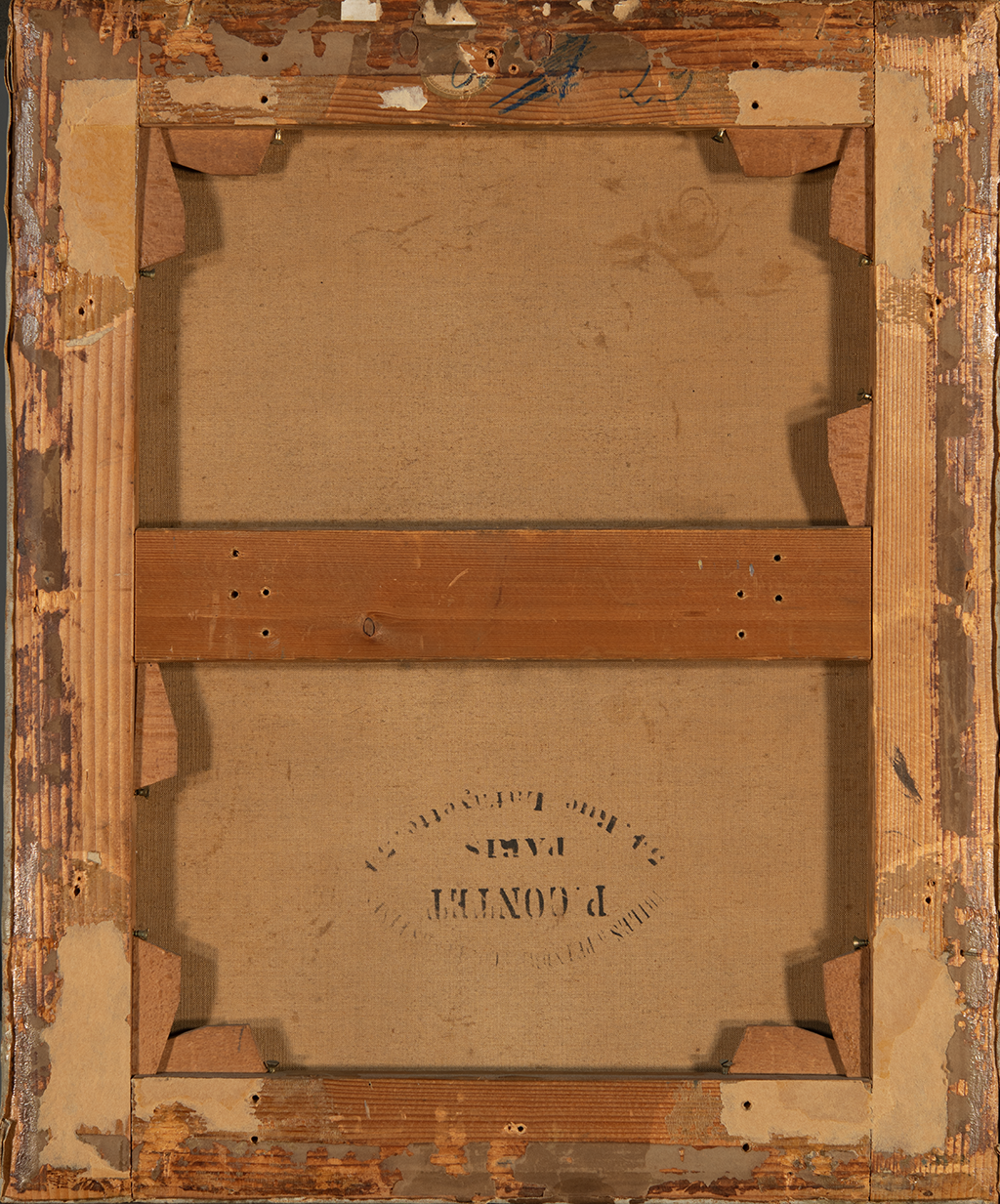 Fig. 6. Overall reverse of The Market at Pontoise (or The Market at Gisors) (1895)
Fig. 6. Overall reverse of The Market at Pontoise (or The Market at Gisors) (1895)
Pissarro first loosely sketched the composition in dry media, followed
by strokes of thin, fluid paint. Black particles, possibly black chalk
or charcoal,3No analysis of Market at Pontoise (or The Market at Gisors) has been undertaken at this time. are evident at the contours of forms and, in many
though not all instances, this material coincides with strokes of dilute
blue paint (Figs. 8, 9). The painted underdrawingunderdrawing: A drawn or painted sketch beneath the paint layer. The underdrawing can be made from dry materials, such as graphite or charcoal, or wet materials, such as ink or paint. is clearly
visible outlining the sleeve of the seated woman, who is less densely
painted than other passages (Fig. 10). A similar underdrawing
technique has been identified beneath Farm at Bazincourt (1884;
Wallraf-Richartz-Museum and Fondation Corboud),4Katja Lewerentz, “Camille Pissarro–Farm at Bazincourt, Brief Report on Technology and Condition,” Research Project Painting Techniques of Impressionism and Postimpressionism, online edition (Cologne, 2008), 4, 12, figs. 9–10, http://forschungsprojekt-impressionismus.de/bilder/pdf/34_e.pdf. Young Peasant Having
Her Coffee (1881; Art Institute of Chicago), and Woman Mending
(1895; Art Institute of Chicago).5“The artist reinforced the major elements in fluid blue paint with a small, flat brush. The blue paint served in part to fix the charcoal, and because the two media mixed on the surface, often they appear as a single medium.” See Kelly Keegan and Kirk Vuillemoot, “Cat. 10 Young Peasant Having Her Coffee, 1881: Technical Report,” in Pissarro Paintings and Works on Paper at the Art Institute of Chicago (Chicago: Art Institute of Chicago, 2015), para 39, https://publications.artic.edu/pissarro/reader/paintingsandpaper/section/21/p-21-22.
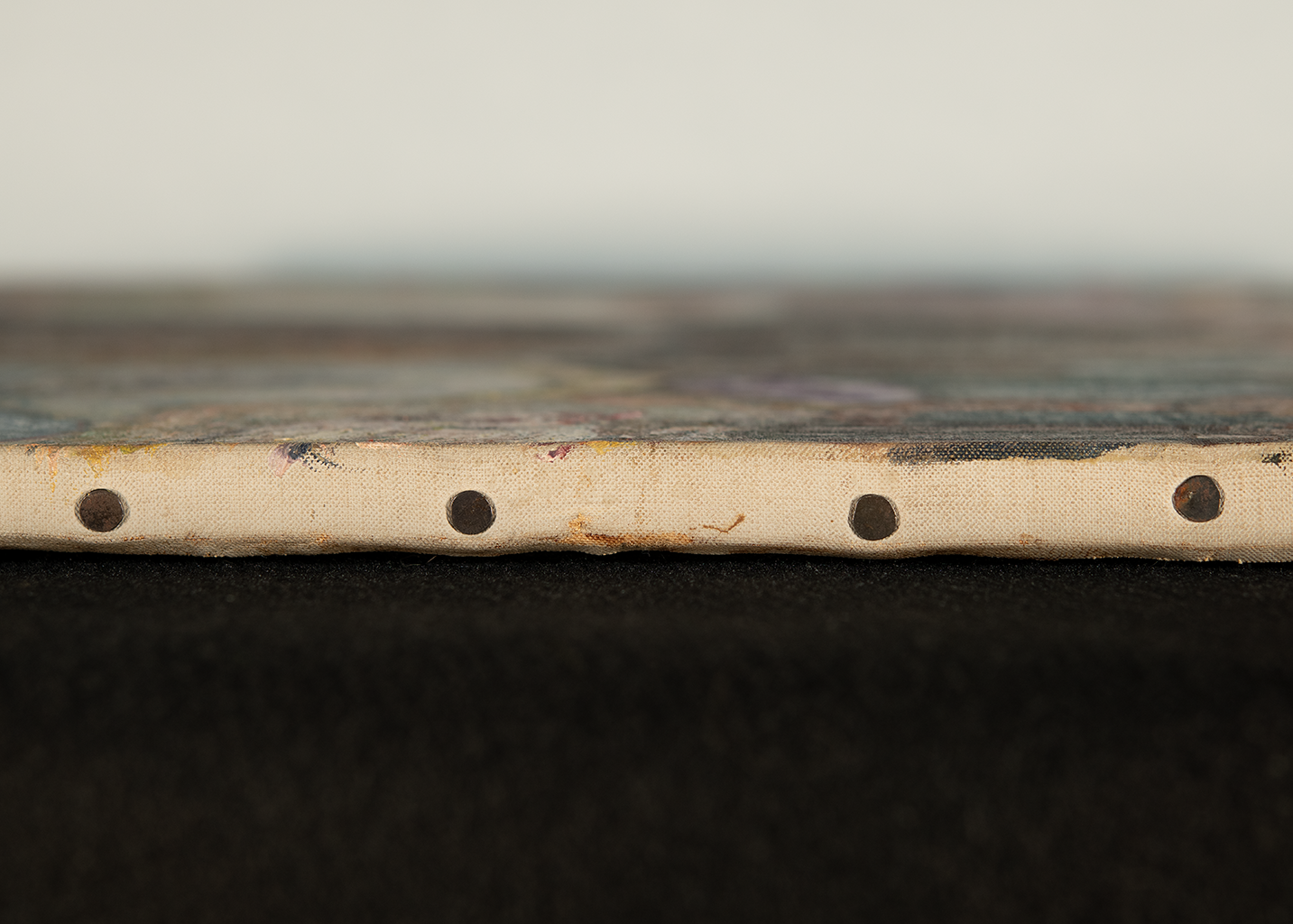 Fig. 7. Detail of the bottom tacking margin of The Market at Pontoise (or The Market at Gisors) (1895), showing the commercially applied ground on the tacking edge and a single set of undisturbed tacks
Fig. 7. Detail of the bottom tacking margin of The Market at Pontoise (or The Market at Gisors) (1895), showing the commercially applied ground on the tacking edge and a single set of undisturbed tacks
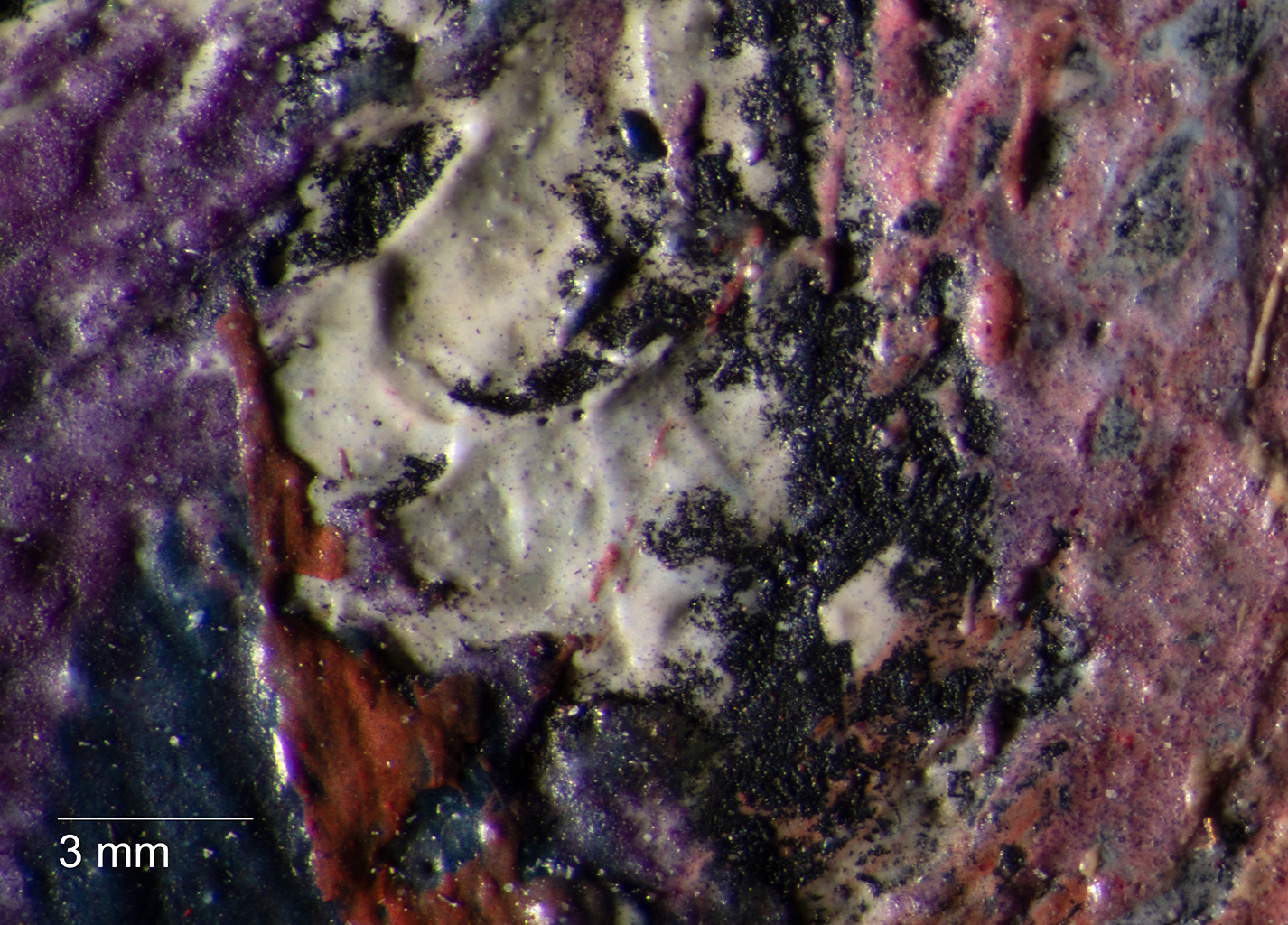 Fig. 8. Photomicrograph with raking illumination, The Market at Pontoise (or The Market at Gisors) (1895), showing the coarse black particles of a sketch line
Fig. 8. Photomicrograph with raking illumination, The Market at Pontoise (or The Market at Gisors) (1895), showing the coarse black particles of a sketch line
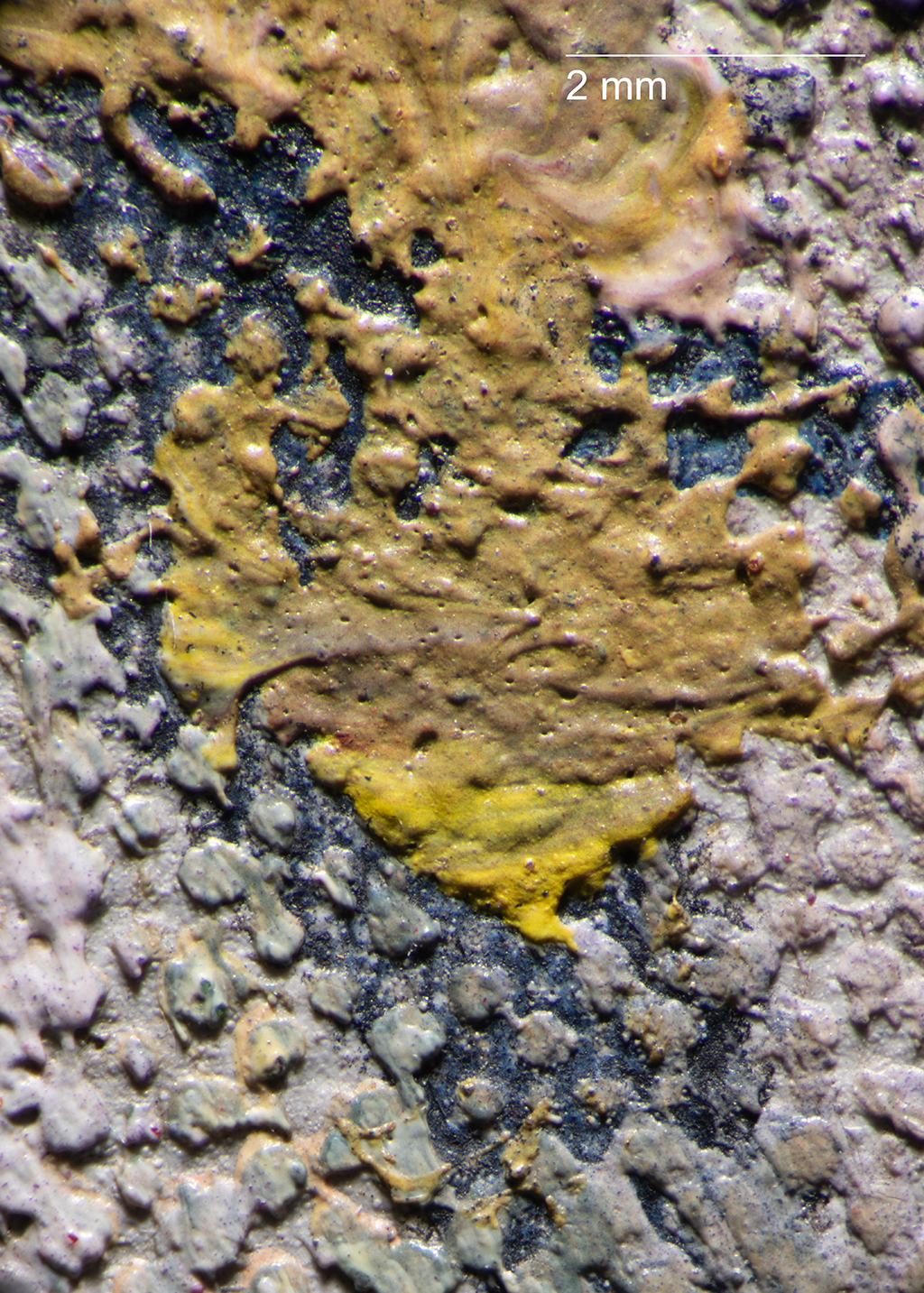 Fig. 9. Photomicrograph with raking illumination, The Market at Pontoise (or The Market at Gisors) (1895), showing the coarse black particles and thin blue paint of the preparatory sketch
Fig. 9. Photomicrograph with raking illumination, The Market at Pontoise (or The Market at Gisors) (1895), showing the coarse black particles and thin blue paint of the preparatory sketch
 Fig. 10. Detail of the seated figure in the lower right of The Market at Pontoise (or The Market at Gisors) (1895)
Fig. 10. Detail of the seated figure in the lower right of The Market at Pontoise (or The Market at Gisors) (1895)
Thick, paste-like paint was applied in a dry manner. In some areas
multiple paint layers create a complex, heavily worked structure that
lacks the spontaneity of plein-airen plein air (adjective: plein-air): French for “outdoors.” The term is used to describe the act of painting quickly outside rather than in a studio. painting (Fig. 11).
Wet-over-drywet-over-dry: An oil painting technique that involves layering paint over an already dried layer, resulting in no intermixing of paint or disruption to the lower paint strokes. brushwork confirms that Pissarro completed The Market at
Pontoise (or The Market at Gisors) over a period of time rather than in a single session. Despite
the heavily painted surface, there are occasional glimpses of the ground
and underdrawing between compositional elements. The x-radiographX-ray radiography (also referred to as x-radiography or radiography): Radiography is an examination tool analogous to the use of X-rays in medicine whereby denser components of a painted composition can be recorded as an inverted shadow image cast on film or a digital X-ray imaging plate from a source such as an X-ray tube. The method has been used for more than a century and is most effective with dense pigments incorporating metallic elements such as lead or zinc. It can reveal artist changes, underlying compositions, and information concerning the artwork’s construction and condition. The resulting image is called an x-radiograph or radiograph. It differs from the uses of X-ray spectrometry in being dependent on the density of the paint to absorb X-rays before they reach the film or image plate and being non-specific as to which elements are responsible for the resulting shadow image. in
Figure 12 underscores these density differences, as thin,
radio-transparent contours appear black in the radiograph, while the
thickly painted forms are radio-opaque and appear white.6Digital radiograph, no. 590, Nelson-Atkins conservation file, 33-150. Using
predominantly round brushes up to 3/8 inches wide, Pissarro’s paint
application includes thick dabs, curving dashes (Fig. 13),
directional strokes, and hatching and cross-hatching brushwork (Figs. 10,
14). Wet-over-wetwet-over-wet: An oil painting technique which involves drawing a stroke of one color across the wet paint of another color. and wet-into-wetwet-into-wet: An oil painting technique which involves blending of colors on the picture surface. painting is present
throughout the surface, occasionally producing a marbleized appearance
(Fig. 15). A few linear canvas weave impressions made in the
wet paint of the distant buildings may be the result of stacking
canvases (Fig. 16).
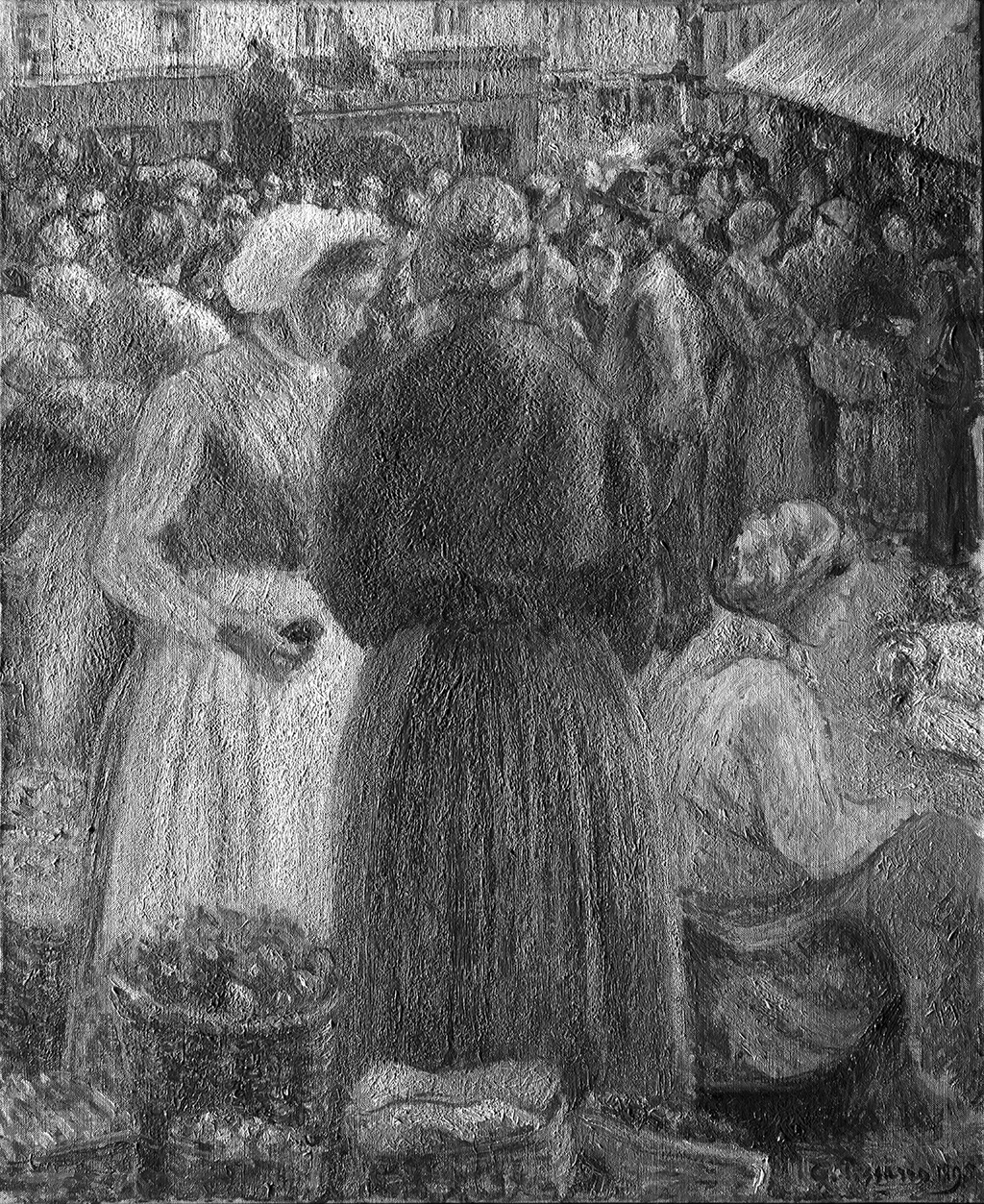 Fig. 11. Raking illumination of The Market at Pontoise (or The Market at Gisors) (1895). Image shown in black and white to highlight the paint texture.
Fig. 11. Raking illumination of The Market at Pontoise (or The Market at Gisors) (1895). Image shown in black and white to highlight the paint texture.
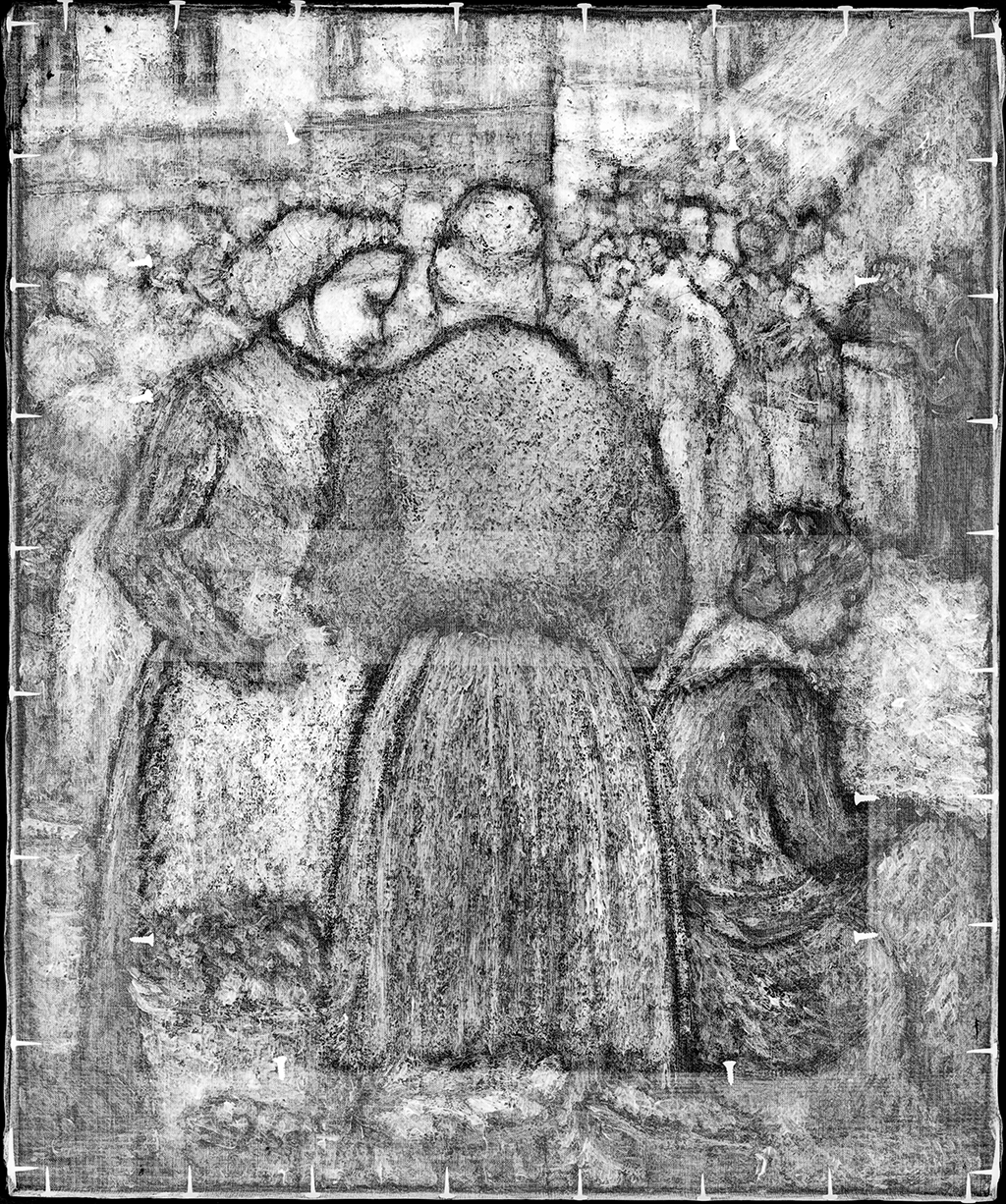 Fig. 12. X-radiograph of The Market at Pontoise (or The Market at Gisors) (1895)
Fig. 12. X-radiograph of The Market at Pontoise (or The Market at Gisors) (1895)
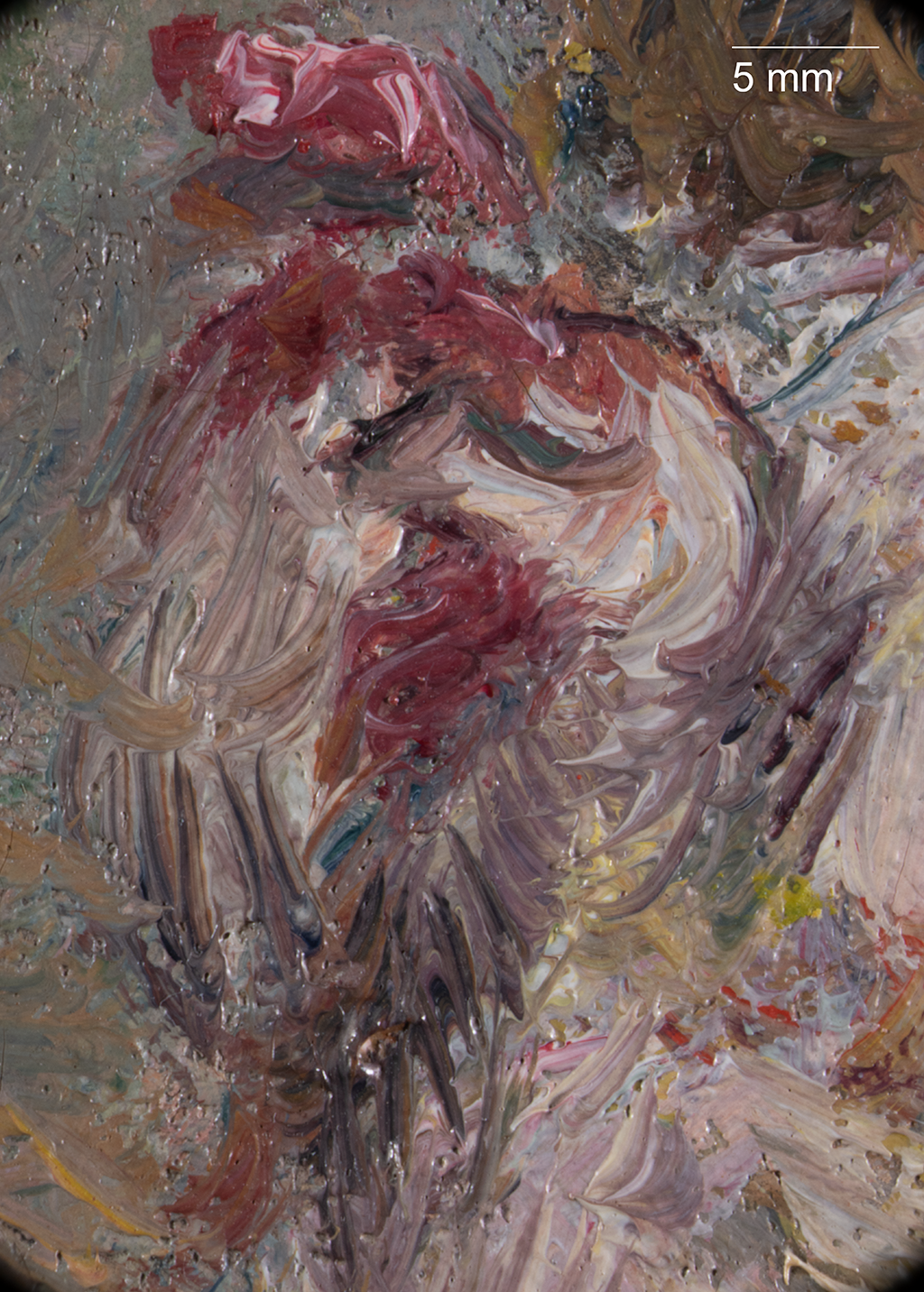 Fig. 13. Photomicrograph of The Market at Pontoise (or The Market at Gisors) (1895), showing the loose curving strokes and wet-into-wet brushwork used to depict the rooster on the lower right
Fig. 13. Photomicrograph of The Market at Pontoise (or The Market at Gisors) (1895), showing the loose curving strokes and wet-into-wet brushwork used to depict the rooster on the lower right
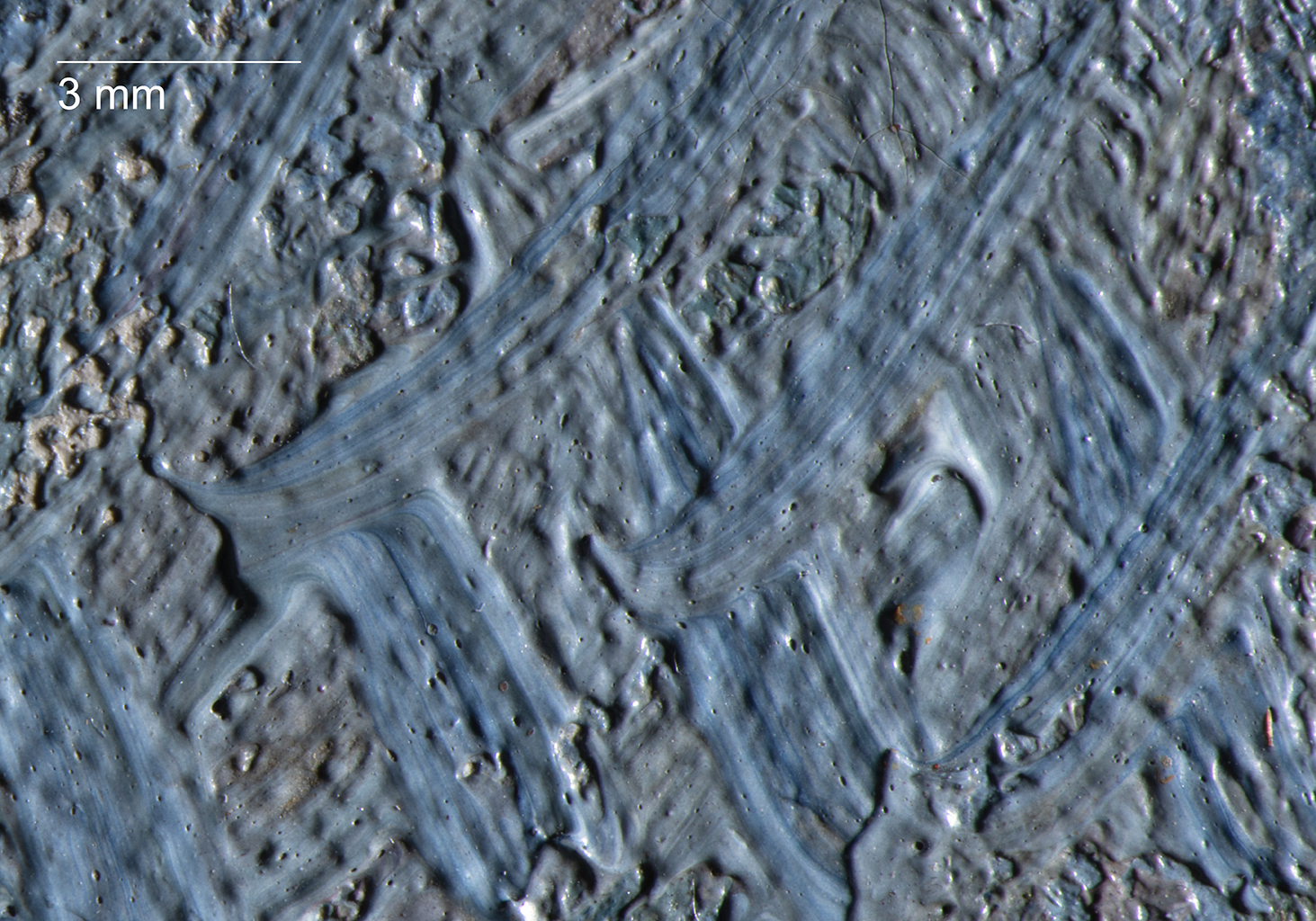 Fig. 14. Photomicrograph with raking illumination, The Market at Pontoise (or The Market at Gisors) (1895), showing the cross-hatching brushwork in the seated figure
Fig. 14. Photomicrograph with raking illumination, The Market at Pontoise (or The Market at Gisors) (1895), showing the cross-hatching brushwork in the seated figure
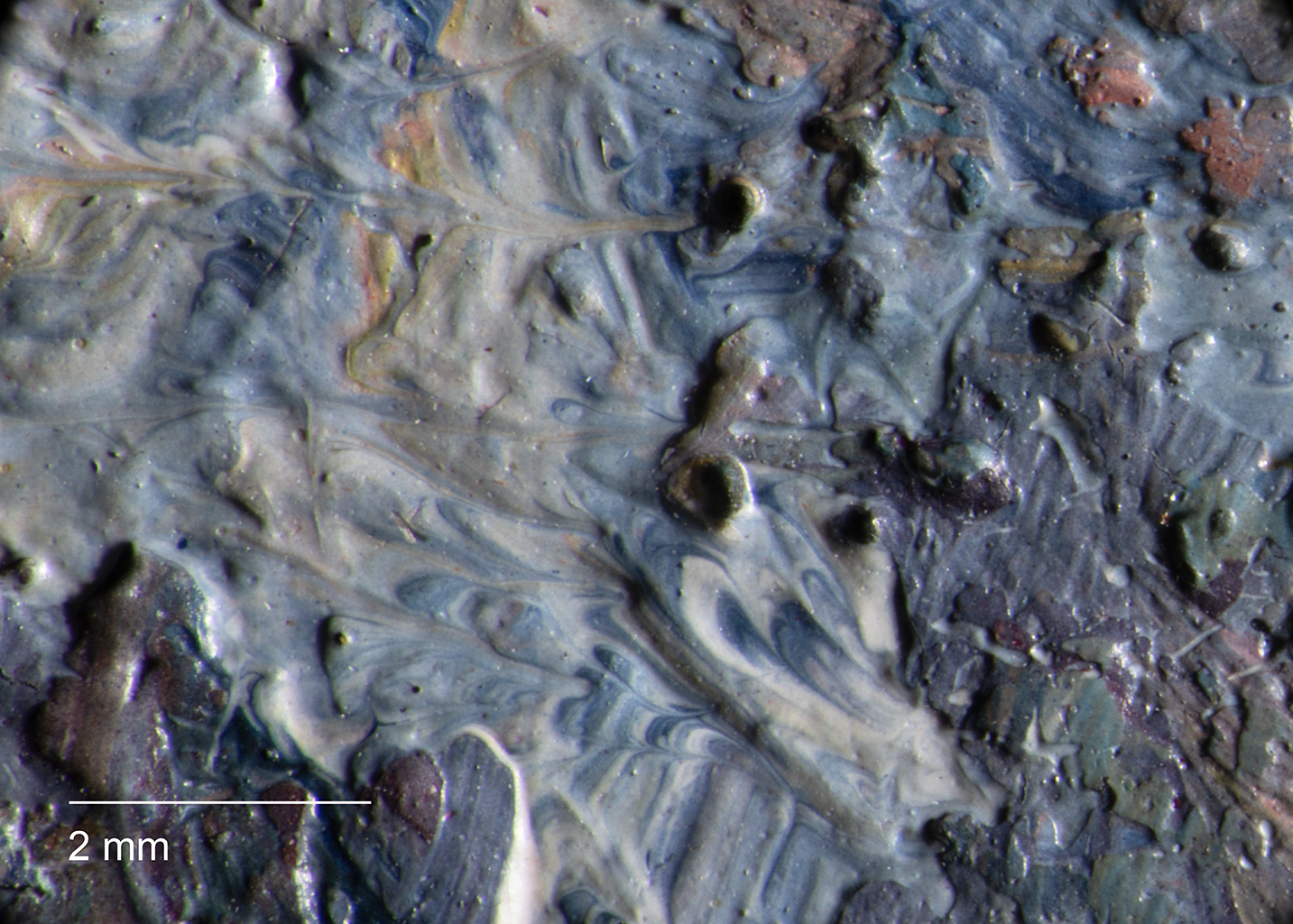 Fig. 15. Photomicrograph with raking illumination, The Market at Pontoise (or The Market at Gisors) (1895), showing the intermixing of colors
Fig. 15. Photomicrograph with raking illumination, The Market at Pontoise (or The Market at Gisors) (1895), showing the intermixing of colors
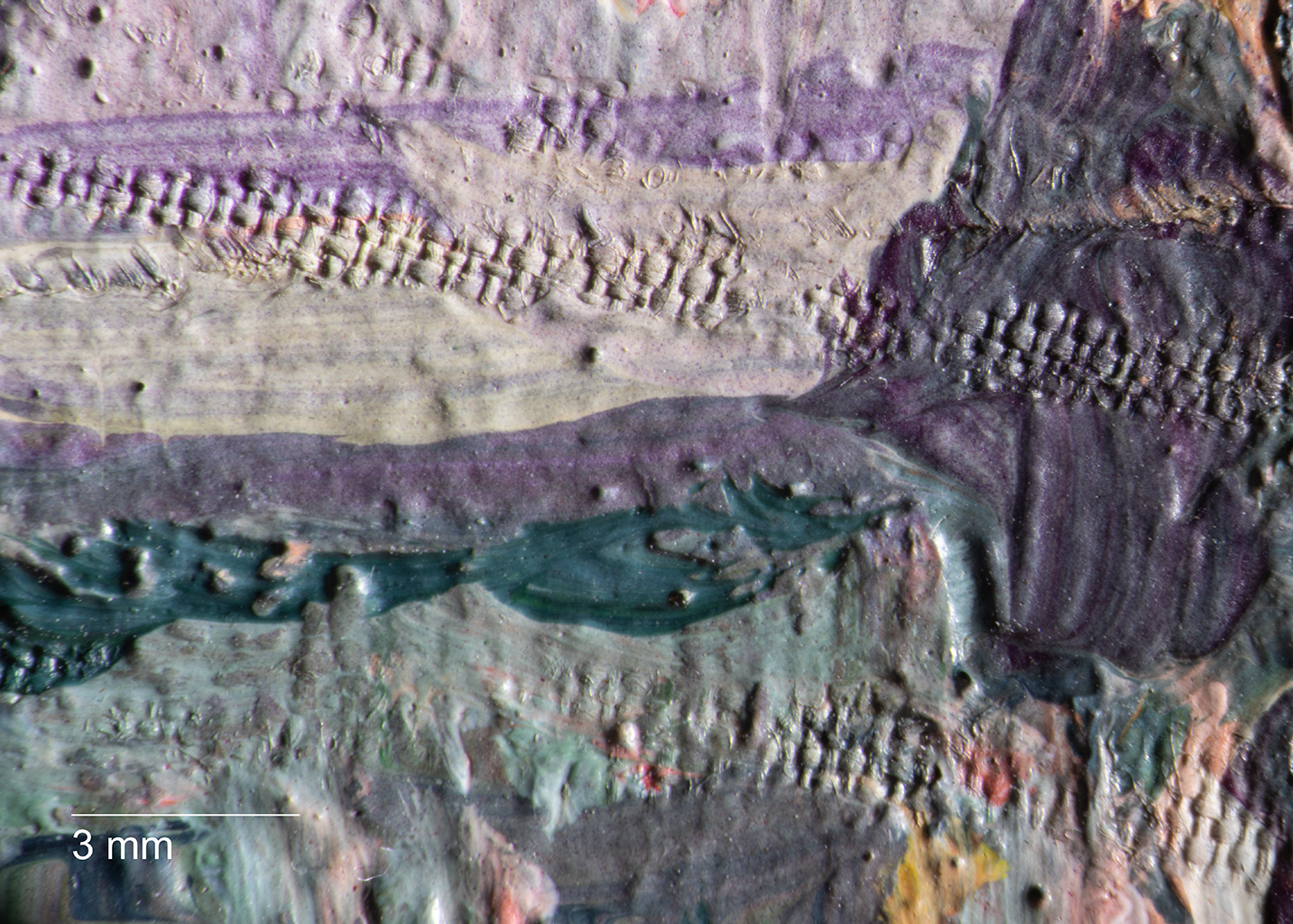 Fig. 16. Photomicrograph with raking illumination, The Market at Pontoise (or The Market at Gisors) (1895), showing several impressions made in the wet paint when a canvas pressed against the surface
Fig. 16. Photomicrograph with raking illumination, The Market at Pontoise (or The Market at Gisors) (1895), showing several impressions made in the wet paint when a canvas pressed against the surface
A number of compositional changes are apparent with radiography and raking illuminationraking light: An examination technique in which light is placed at a shallow angle from one direction to reveal the surface topography.. In his rendering of the buildings, Pissarro dragged
a sharp tool or the end of a brush through the wet paint, producing
incised lines to mark the architectural perspective and upper left
windows. These early marks confirm that the windows were later cropped
roughly one centimeter. X-radiography reveals that the awning was
initially a narrow shape that extended six to seven centimeters further (Fig.
17), similar to the awning portrayed in Le Marché de Pontoise
(1889; private collection) (see Fig. 5). At a later
stage, Pissarro widened the awning five centimeters toward the right edge,
and differences in texture and dark, underlying paint reveal this
pentimentopentimento (pl: pentimenti): A change to the composition made by the artist that is visible on the paint surface. Often with time, pentimenti become more visible as the upper layers of paint become more transparent with age. Italian for "repentance" or "a change of mind.". The two rightmost figures were originally shorter and
painted in full profile, and a nearby woman with a yellow scarf appears
to have once held a child (Fig. 18). Where these artist changes
occurred on the upper right, a small amount of lightly scraped paint is
evident with the stereomicroscope, an aspect of Pissarro’s technique
that has been documented on other paintings where artist revisions
occurred.7See Kelly Keegan and Kirk Vuillemot, “Cat. 3 Snow at Louveciennes, c. 1870: Technical Report,” Pissarro Paintings and Works on Paper, para 32; Kelly Keegan and Kirk Vuillemot, “Cat. 8 Rabbit Warren at Pontoise, Snow,” Pissarro Paintings and Works on Paper, para 12 and 30. Pentimenti signal a few other minor adjustments: the
central and left females shifted slightly at the proper left and
proper right arms, respectively, and the central figure’s skirt was
cropped one centimeter on the left.
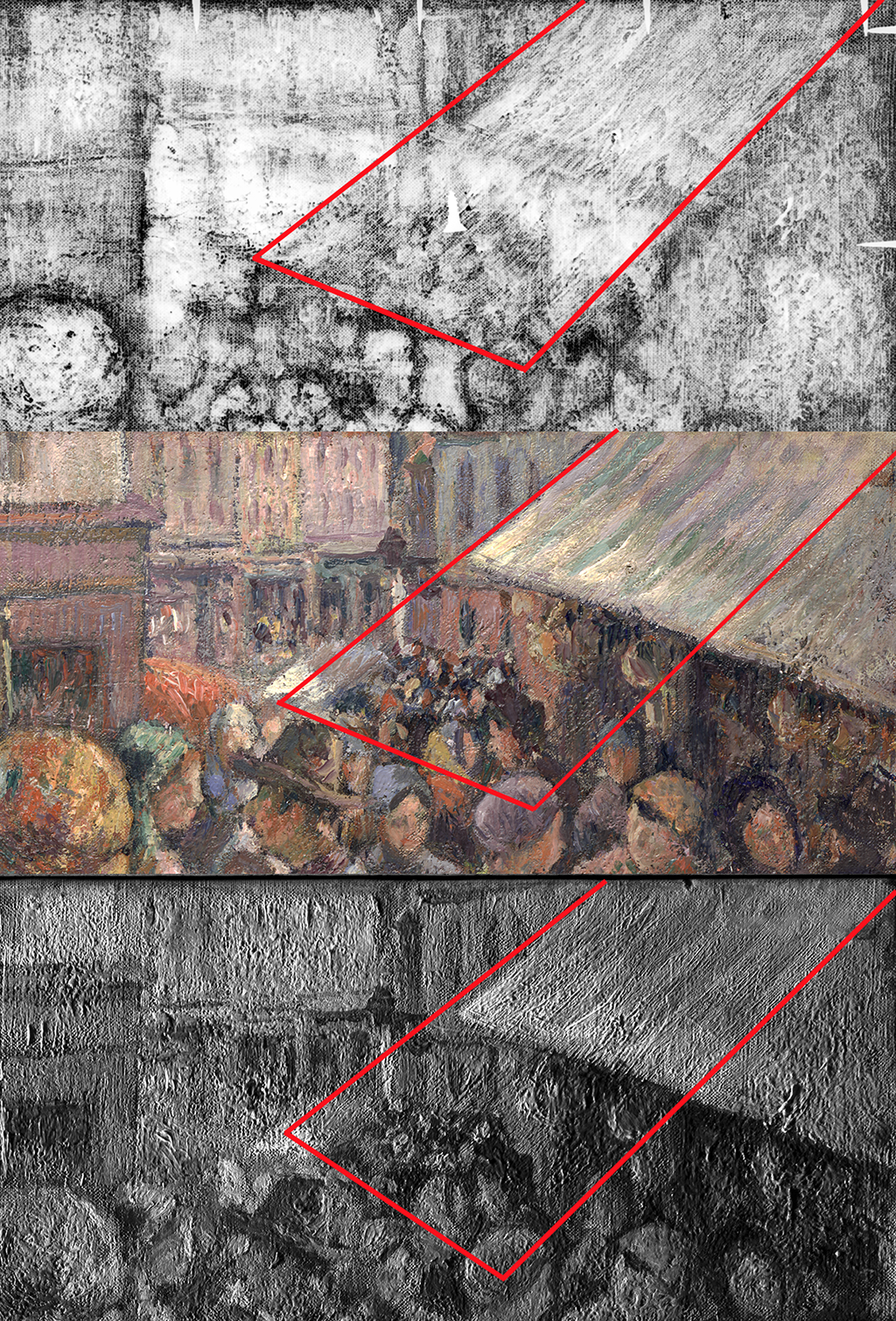 Fig. 17. Details of the top edge of The Market at Pontoise (or The Market at Gisors) (1895): digital radiograph (top), normal illumination (center), and raking illumination (bottom). Red outlines mark the earlier shape of the awning, and thick linear brushstrokes in this area are visible in the top and bottom details.
Fig. 17. Details of the top edge of The Market at Pontoise (or The Market at Gisors) (1895): digital radiograph (top), normal illumination (center), and raking illumination (bottom). Red outlines mark the earlier shape of the awning, and thick linear brushstrokes in this area are visible in the top and bottom details.
 Fig. 18. Details of the center right figures, The Market at Pontoise (or The Market at Gisors) (1895). The detail with normal illumination (left) and digital x-radiograph (right) reveal changes to the figures.
Fig. 18. Details of the center right figures, The Market at Pontoise (or The Market at Gisors) (1895). The detail with normal illumination (left) and digital x-radiograph (right) reveal changes to the figures.
The painting is in good condition for its age, although a small vertical cut in the canvas exists on the lower right edge (approximately one centimeter). In 1980, a discolored natural resin varnish was reduced, and several impact cracksimpact cracks: A characteristic crack pattern that forms after a blow to a painting. When these appear as circular, spiral, or spiderweb-like, they are sometimes called sigmoid cracks. and stretcher cracksstretcher cracks: Linear cracks or deformations in the painting’s surface that correspond to the inner edges of the underlying stretcher or strainer members. were treated.8Forrest Bailey, April 28, 1980, treatment report, NAMA conservation file, 33-150. A synthetic varnish was removed from the painting in 2006,9Mary Schafer, September 12, 2006, treatment report, Nelson-Atkins conservation file, 33-150. and the surface was left unvarnished.10By the 1880s, it was clear that Pissarro opposed varnish. On the verso of Landscape at Chaponval (1880; Musée d’Orsay), he wrote on a label: “please do not varnish this picture, C. Pissarro.” See David Bomford, Jo Kirby, John Leighton, and Ashok Roy, Art in the Making: Impressionism (London: Yale University Press, 1991), 101; Michael Swicklick, “French Painting and the Use of Varnish, 1750-1900,” Conservation Research: Studies in the History of Art 41, no. 2 (1993): 168–69; Anthea Callen, “The Unvarnished Truth: Mattness, ‘Primitivism,’ and Modernity in French Painting, c. 1870–1907,” Burlington Magazine 136, no. 1100 (November 1994): 738. Only a few spots of retouchingretouching: Paint application by a conservator or restorer to cover losses and unify the original composition. Retouching is an aspect of conservation treatment that is aesthetic in nature and that differs from more limited procedures undertaken solely to stabilize original material. Sometimes referred to as inpainting or retouch. were necessary to address a small fillfill material: A material added to a loss of paint and/or ground to create an area level with the surrounding original paint. on the upper left corner and abrasionabrasion: A loss of surface material due to rubbing, scraping, frequent touching, or inexpert solvent cleaning. at the bottom edge.
Notes
-
Located on the lower center of the canvas, oriented 180 degrees from the market scene on the obverse, the stenciled stamp reads: “TOILES à PEIN[DRE à COULEURS FINE] / P. CONTET / PARIS / [3]4, Rue Lafayette[, 3]4.”
-
See sale list of commercial canvases offered by the Bourgeois Ainé company from 1888 in Iris Schaefer, Caroline von Saint-George, and Katja Lewerentz, Painting Light: The Hidden Techniques of the Impressionists (Milan: Skira, 2008), 50.
-
No analysis of The Market at Pontoise (or The Market at Gisors) has been undertaken at this time.
-
Katja Lewerentz, “Camille Pissarro–Farm at Bazincourt, Brief Report on Technology and Condition,” Research Project Painting Techniques of Impressionism and Postimpressionism, online edition (Cologne, 2008), 4, 12, figs. 9–10, http://forschungsprojekt-impressionismus.de/bilder/pdf/34_e.pdf.
-
“The artist reinforced the major elements in fluid blue paint with a small, flat brush. The blue paint served in part to fix the charcoal, and because the two media mixed on the surface, often they appear as a single medium.” See Kelly Keegan and Kirk Vuillemoot, “Cat. 10, Young Peasant Having Her Coffee, 1881: Technical Report,” in Pissarro Paintings and Works on Paper at the Art Institute of Chicago (Chicago: Art Institute of Chicago, 2015), para 39, http://forschungsprojekt-impressionismus.de/bilder/pdf/34_e.pdf.
-
Digital radiograph, no. 590, Nelson-Atkins conservation file, 33-150.
-
See Kelly Keegan and Kirk Vuillemot, “Cat. 3 Snow at Louveciennes, c. 1870: Technical Report,” Pissarro Paintings and Works on Paper, para 32; Kelly Keegan and Kirk Vuillemot, “Cat. 8 Rabbit Warren at Pontoise, Snow,” Pissarro Paintings and Works on Paper, para 12 and 30.
-
Forrest Bailey, April 28, 1980, treatment report, NAMA conservation file, 33-150.
-
Mary Schafer, September 12, 2006, treatment report, Nelson-Atkins conservation file, 33-150.
-
By the 1880s, it was clear that Pissarro opposed varnish. On the verso of Landscape at Chaponval (1880; Musée d’Orsay), he wrote on a label: “please do not varnish this picture, C. Pissarro.” See David Bomford, Jo Kirby, John Leighton, and Ashok Roy, Art in the Making: Impressionism (London: Yale University Press, 1991), 101; Michael Swicklick, “French Painting and the Use of Varnish, 1750–1900,” Conservation Research: Studies in the History of Art 41, no. 2 (1993): 168–69; Anthea Callen, “The Unvarnished Truth: Mattness, ‘Primitivism,’ and Modernity in French Painting, c. 1870–1907,” Burlington Magazine 136, no. 1100 (November 1994): 738.
Documentation
Citation
Chicago:
Danielle Hampton Cullen, “Camille Pissarro, The Market at Pontoise (or The Market at Gisors), 1895,” documentation in French Paintings and Pastels, 1600–1945: The Collections of The Nelson-Atkins Museum of Art, ed. Aimee Marcereau DeGalan (Kansas City: The Nelson-Atkins Museum of Art, 2023), https://doi.org/10.37764/78973.5.648.4033.
MLA:
Hampton Cullen, Danielle. “Camille Pissarro, The Market at Pontoise (or The Market at Gisors), 1895,” documentation. French Paintings and Pastels, 1600–1945: The Collections of The Nelson-Atkins Museum of Art, edited by Aimee Marcereau DeGalan, Nelson-Atkins Museum of Art, 2023. doi: 10.37764/78973.5.648.4033.
Provenance
Citation
Chicago:
Danielle Hampton Cullen, “Camille Pissarro, The Market at Pontoise (or The Market at Gisors), 1895,” documentation in French Paintings and Pastels, 1600–1945: The Collections of The Nelson-Atkins Museum of Art, ed. Aimee Marcereau DeGalan (Kansas City: The Nelson-Atkins Museum of Art, 2023), https://doi.org/10.37764/78973.5.648.4033.
MLA:
Hampton Cullen, Danielle. “Camille Pissarro, The Market at Pontoise (or The Market at Gisors), 1895,” documentation. French Paintings and Pastels, 1600–1945: The Collections of The Nelson-Atkins Museum of Art, edited by Aimee Marcereau DeGalan, Nelson-Atkins Museum of Art, 2023. doi: 10.37764/78973.5.648.4033.
Given by the artist to André Teissier (b. 1861), Mâcon, France, by July 4, 1903–at least August 3, 1904 [1];
With Galerie de l’Élysée, Paris [2];
With Galerie Saint-Pierre d’Alfred Poyet, Lyon, France, as Le Marché à Gisors, by May 10, 1929 [3];
With Jacques Dubourg, Paris, by July 20, 1929;
Purchased from Dubourg by C . W. Kraushaar Art Galleries, New York, stock no. 24704, as Marché à Pontoise, 1929–May 5, 1933 [4];
Purchased from Kraushaar by The Nelson-Atkins Museum of Art, Kansas City, MO, 1933.
Notes
[1] Teissier was Pissarro’s notary and friend; he may have received the painting as a gift from the artist as early as 1900. See Joachim Pissarro and Claire Durand-Ruel-Snollaerts, Pissarro: Catalogue critique des peintures; Critical Catalogue of Paintings (Milan: Skira Editore, 2005), 3:693.
This painting was lent by Teissier to the Exposition des Beaux-Arts, Ville de Mâcon, France, July 4–August 24, 1903, no. 657, as Pontoise (le marché). None of the paintings were sold during this exhibition. See correspondence from José Raymond, Assistant de conservation, Archives municipales de Mâcon, to Danielle Hampton Cullen, The Nelson-Atkins Museum of Art, June 11, 2021, NAMA curatorial files.
The painting does not appear in Pissarro’s will, indicating that Teissier was still the owner in 1904. See Teissier, “Dépôt de Partage de la communauté Pissarro,” Archives Departementales de Saône-et-Loire, Mâcon, France, Series 3E 24166.
[2] Jean Metthey (1904–1955) founded the Galerie de l’Élysée at 69 rue du Faubourg Saint-Honoré in 1935. He was listed as an individual owner of the painting in the 1939 catalogue raisonné, but not in the 2005 edition, which instead lists the Galerie de l’Élysée. See Ludovic Rodo Pissarro and Lionello Venturi, Camille Pissarro, Son art, Son Œuvre (Paris: Paul Rosenberg, 1939), no. 932, pp. 1:63, 210; and Joachim Pissarro and Claire Durand-Ruel Snollaerts, Pissarro: Catalogue critique des peintures; Critical Catalogue of Paintings (Paris: Wildenstein Institute Publications, 2005), no. 1097, pp. 3:696. Since this gallery was founded after the date that the Nelson-Atkins acquired the painting in 1933, it would not be the correct one.
Another Galerie de l’Élysée was located at 25 rue La-Boétie as early as 1919 until at least 1922. See advertisements in these years for this gallery in La Chronique des arts et de la curiosité: supplément à la Gazette des beaux-arts. It is unclear who founded and directed this establishment.
[3] This painting was exhibited at the Camille Pissarro, Galerie Saint-Pierre d’Alfred Poyet, Lyon, France, May 1929, no. 8, as Le Marché à Gisors. As a commercial gallery, all the works exhibited were owned by the Galerie and were for sale.
[4] See Archives of American Art, Smithsonian Institution, Washington, D. C., Kraushaar Galleries Records, 1885–2006, Series 6.4, Financial Records, 1885–1957, Purchase Journal, 1928–1940, Box 74, Folder 7, page 62; and Sales Journal, 1930–1943, box 76, folder 3, page 136.
Related Works
Citation
Chicago:
Danielle Hampton Cullen, “Camille Pissarro, The Market at Pontoise (or The Market at Gisors), 1895,” documentation in French Paintings and Pastels, 1600–1945: The Collections of The Nelson-Atkins Museum of Art, ed. Aimee Marcereau DeGalan (Kansas City: The Nelson-Atkins Museum of Art, 2023), https://doi.org/10.37764/78973.5.648.4033.
MLA:
Hampton Cullen, Danielle. “Camille Pissarro, The Market at Pontoise (or The Market at Gisors), 1895,” documentation. French Paintings and Pastels, 1600–1945: The Collections of The Nelson-Atkins Museum of Art, edited by Aimee Marcereau DeGalan, Nelson-Atkins Museum of Art, 2023. doi: 10.37764/78973.5.648.4033.
Camille Pissarro, The Marketplace, Gisors, 1891, opaque watercolor with black conté crayon over traces of charcoal on fabric mounted to thin cardboard, Sheet: 14 x 10 1/4 in. (35.6 x 26 cm), Philadelphia Museum of Art, 1963-181-55.
Camille Pissarro, Market at Pontoise, ca. 1895, lithograph on paper, first state, 12 1/8 x 9 in. (30.8 x 22.7 cm), National Gallery of Art, Washington, DC, 1974.27.2.
Camille Pissarro, The Market at Pontoise, ca. 1895, lithograph on paper, second state, image: 11 7/8 x 8 11/16 in. (30.1 x 22.1 cm), sheet: 17 11/16 x 12 5/16 in. (45 x 31.2 cm), The Clark Art Institute, Williamstown, MA, 1962.95.
Camille Pissarro, Market in Pontoise, ca. 1895, lithograph in black on cream wove paper, laid down on ivory wove paper, third state, image: 12 1/8 x 9 in. (30.8 x 22.7 cm), sheet: 17 1/4 x 12 1/2 in. (43.9 x 31.6 cm), The Art Institute of Chicago, 2017.40.
Camille Pissarro, The Market at Pontoise, ca. 1895, charcoal and wash on paper, 12 x 9 1/8 in. (30.4 x 23.3. cm), location unknown, illustrated in advertisement, JPL Fine Arts, London. Copy in Musée d’Orsay, Documentation Center, Paris, Pissarro, box 47.
Exhibitions
Citation
Chicago:
Danielle Hampton Cullen, “Camille Pissarro, The Market at Pontoise (or The Market at Gisors), 1895,” documentation in French Paintings and Pastels, 1600–1945: The Collections of The Nelson-Atkins Museum of Art, ed. Aimee Marcereau DeGalan (Kansas City: The Nelson-Atkins Museum of Art, 2023), https://doi.org/10.37764/78973.5.648.4033.
MLA:
Hampton Cullen, Danielle. “Camille Pissarro, The Market at Pontoise (or The Market at Gisors), 1895,” documentation. French Paintings and Pastels, 1600–1945: The Collections of The Nelson-Atkins Museum of Art, edited by Aimee Marcereau DeGalan, Nelson-Atkins Museum of Art, 2023. doi: 10.37764/78973.5.648.4033.
Exposition des Beaux-Arts, Ville de Mâcon, France, July 4–August 24, 1903, no. 657, as Pontoise (le marché).
The Second Exhibition of Works by Members of the Monarro Group, The Goupil Gallery, London, March 1921, no. 55, as Marché de Gisors.
Camille Pissarro, Galerie Saint-Pierre d’Alfred Poyet, Lyons, France, May 1929, no cat., no. 8, as Le Marché à Gisors.
Exhibition of Modern French Paintings, Water Colors and Drawings, C.W. Kraushaar Art Galleries, New York, October 5–28, 1929, no. 20, as Market at Pontoise.
French Paintings and Sculpture from the Kraushaar Galleries, New York, and Private Collections, The Art Gallery of Toronto, December 1929, no. 215, as Market at Pontoise.
Exhibition of Modern French Paintings, Water Colors and Drawings, C.W. Kraushaar Art Galleries, New York, October 11–November 5, 1932, no. cat.
Homage to Camille Pissarro: The Last Years, 1890–1903, Dixon Gallery and Gardens, Memphis, TN, May 18–June 22, 1980, no. 7, as Le Marché a Gisors, Market at Pontoise.
Rétrospective Camille Pissarro, Isetan Museum of Art, Tokyo, March 9–April 9, 1984; Fukuoka Art Museum, Fukuoka, April 25–May 20, 1984; Kyoto Municipal Museum of Art, Kyoto, May 26–July 1, 1984, no. 50, as Le Marché à Gisors.
Impressionism: Selections from Five American Museums, The Carnegie Museum of Art, Pittsburgh, November 4–December 31, 1989; The Minneapolis Institute of Arts, January 27–March 25, 1990; The Nelson-Atkins Museum of Art, Kansas City, MO, April 21–June 17, 1990; The Saint Louis Art Museum, July 14–September 9, 1990; The Toledo Museum of Art, September 30–November 25, 1990, no. 65, as Market at Pontoise.
Impressionism to the Present: Camille Pissarro and His Descendants, Museum of Art, Fort Lauderdale, FL, January 29–April 30, 2000, no. 62, as Market at Pontoise.
Pissarro’s People, The Sterling and Francine Clark Art Institute, Williamstown, MA, June 12–October 2, 2011; California Palace of the Legion of Honor, San Francisco, October 22, 2011–January 22, 2012, no. 176, Market at Gisors.
Camille Pissarro: Le premier des impressionnistes, Musée Marmottan Monet, Paris, February 23–July 2, 2017, no. 34, as Market at Pontoise.
From Farm to Table: Impressionist and Post-Impressionist Masterworks on Paper, The Nelson-Atkins Museum of Art, Kansas City, MO, August 12, 2017–Jaunuary 21, 2018, no cat.
References
Citation
Chicago:
Danielle Hampton Cullen, “Camille Pissarro, The Market at Pontoise (or The Market at Gisors), 1895,” documentation in French Paintings and Pastels, 1600–1945: The Collections of The Nelson-Atkins Museum of Art, ed. Aimee Marcereau DeGalan (Kansas City: The Nelson-Atkins Museum of Art, 2023), https://doi.org/10.37764/78973.5.648.4033.
MLA:
Hampton Cullen, Danielle. “Camille Pissarro, The Market at Pontoise (or The Market at Gisors), 1895,” documentation. French Paintings and Pastels, 1600–1945: The Collections of The Nelson-Atkins Museum of Art, edited by Aimee Marcereau DeGalan, Nelson-Atkins Museum of Art, 2023. doi: 10.37764/78973.5.648.4033.
Exposition des Beaux-Arts, exh. cat. (Mâcon: Buguet-Comptour, 1903), 69, as Pontoise (le marché).
The Second Exhibition of Works by Members of the Monarro Group, exh. cat. (London: Goupil Gallery, 1921), 7, as Marché de Gisors.
Exhibition of Modern French Paintings, Water Colors and Drawings, exh. cat. (New York: C.W. Kraushaar Art Galleries, 1929), unpaginated, (repro.), as Market at Pontoise.
Catalogue of an Exhibition of French Paintings and Sculpture from the Kraushaar Galleries, New York, and Private Collections, exh. cat. (Toronto: Art Gallery of Ontario, 1929), 5–6, (repro.), as Market at Pontoise.
Edward Alden Jewell, “Kraushaar Shows French Work,” New York Times 82, no. 27,290 (October 12, 1932): 28, as Market at Pontoise.
“In Gallery and Studio,” Kansas City Star 53, no. 266 (June 10, 1933): 4.
“Nelson Gallery of Art Special Number,” Art Digest, no. 5 (December 1, 1933): 14, 22, as Market at Pontoise.
“The William Rockhill Nelson Gallery of Art, Kansas City Special Number,” Art News 32, no. 10 (December 9, 1933): 28, 30, 44, (repro.), as Market at Pontoise.
Minna K. Powell, “The First Exhibition of the Great Art Treasures,” Kansas City Star 54, no. 84 (December 10, 1933): 4C.
George H. Leonard, “Art and Life,” Holyoke (MA) Daily Transcript; The Holyoke Telegram, no. 16,200 (December 16, 1933): 8.
Paul V. Beckley, “Art News,” Kansas City Journal Post 80, no. 193 (December 17, 1933): 2C.
The William Rockhill Nelson Gallery of Art and Mary Atkins Museum of Fine Arts, Handbook of the William Rockhill Nelson Gallery of Art (Kansas City, MO: William Rockhill Nelson Gallery of Art and Mary Atkins Museum of Fine Arts, 1933), 137, as Market at Pontoise.
A. J. Philpott, “Kansas City Now in Art Center Class: Nelson Gallery, Just Opened, Contains Remarkable Collection of Paintings, Both Foreign and American,” Boston Sunday Globe 125, no. 14 (January 14, 1934): 16.
M[inna] K. P[owell], “Cezanne and the Patches of Color by Which He Transformed Modern Art,” Kansas City Star 54, no. 120 (January 15, 1934): [16]D.
D[orothy] A[dlow], “The Home Forum,” Christian Science Monitor (August 10, 1937): 8, (repro.), as Market at Pontoise.
Nan Sheets, “Old World Moderns Win the Art Prizes,” Manhattan (KS) Mercury (November 7, 1937), clipping, scrapbooks, NAMA archives, as Market at Pontoise.
Ludovic Rodo Pissarro and Lionello Venturi, Camille Pissarro, Son art, Son Œuvre (Paris: Paul Rosenberg, 1939), no. 932, pp. 1:63, 210; 2: unpaginated, (repro.), as Le Marché a [sic] Gisors.
The William Rockhill Nelson Gallery of Art and Mary Atkins Museum of Fine Arts, The William Rockhill Nelson Collection, 2nd ed. (Kansas City, MO: William Rockhill Nelson Gallery of Art and Mary Atkins Museum of Fine Arts, 1941), 41, 168, as Market at Pontoise.
Ross E. Taggart, ed., Handbook of the Collections in the William Rockhill Nelson Gallery of Art and Mary Atkins Museum of Fine Arts, 4th ed. (Kansas City, MO: William Rockhill Nelson Gallery of Art and Mary Atkins Museum of Fine Arts, 1959), 261, as Market at Pontoise.
Bill Graves, “Pissarro: Dean of Impressionist Painters,” Kansas City Times 123, no. 294 (December 8, 1960): 10D, as Market at Pontoise.
Ross E. Taggart and George L. McKenna, eds., Handbook of the Collections in The William Rockhill Nelson Gallery of Art and Mary Atkins Museum of Fine Arts, Kansas City, Missouri, vol. 1, Art of the Occident, 5th ed. (Kansas City, MO: William Rockhill Nelson Gallery of Art and Mary Atkins Museum of Fine Arts, 1973), 163, 258, (repro.), as Market at Pontoise.
Charles Kunstler, Camille Pissarro (Milan: Fratelli Fabbri Editori, 1974), 66, (repro.), as Le Marché à Gisors.
Michael Milkovich, ed., Homage to Camille Pissarro: The Last Years, 1890–1903, exh. cat. (Memphis, TN: Dixon Gallery and Gardens, 1980), 23–24, 39, (repro.), as Le Marché a [sic] Gisors.
John Rewald et al., Pissarro: Camille Pissarro, 1830–1903, exh. cat. (London: Arts Council of Great Britain, 1980), 224, as Gisors Market.
Richard R. Brettell et. al, Retrospective Camille Pissarro, exh. cat. (Tokyo: Isetan Museum of Art, 1984), 74, 136–37, (repro.), as Le Marché à Gisors.
“Friends of Art: Guild Travel,” Calendar of Events (The Nelson-Atkins Museum of Art) (June 1985): (repro.), as Market at Pontoise.
Christopher Lloyd, “The Market Scenes of Camille Pissarro,” Art Bulletin of Victoria, no. 25 (1985): 26–27, 29, (repro.), as Le Marché à Pontoise.
Christopher Lloyd, ed., Studies on Camille Pissarro (London: Routledge and Kegan Paul, 1986), viii, 24, 31, (repro.), as Le Marché à Pontoise (formerly Gisors).
Janine Bailly-Herzberg, ed., Correspondance de Camille Pissarro (Paris: Editions du Valhermeil, 1989), 4:26, as Marché.
Marc S. Gerstein, Impressionism: Selections from Five American Museums, exh. cat. (New York: Hudson Hills Press, 1989), 12, 152–53, (repro), as Market at Pontoise.
“Impressionism Exhibit Brings the Best of 19th Century Art from Five American Museums to KC,” The Call 70, no. 39 (April 20, 1990): 14, (repro.), as Market at Pontoise.
Ludovico Rodo Pissarro and Lionello Venturi, Camille Pissarro, Son Art—Son Œuvre, 2nd rev. ed. (San Francisco: Alan Wofsy Fine Arts, 1989), no. 932, pp. 1:63, 210, 2: (repro.), as Le Marché a [sic] Gisors.
Bernard Denvir, The Chronicle of Impressionism: An Intimate Diary of the Lives and World of the Great Artists (London: Thames and Hudson, 1993), 279.
Joachim Pissarro, Camille Pissarro (New York: Harry N. Abrams, 1993), 209–10, (repro.), as Market at Pontoise.
Paul Smith, Impressionism: Beneath the Surface (New York: Harry N. Abrams, 1995), 132, 134, (repro.), as The Market at Pontoise.
Jean Leymaire et al., Camille Pissarro, exh. cat. (Ferrara, Italy: Palazzo dei Diamanti, 1998), 194.
Loys Delteil et al., Camille Pissarro: l’oeuvre gravé et lithographié (San Francisco, CA: Alan Wofsy Fine Arts, 1999), 317.
David S. Stern and Talma Zakai-Kanner, Impressionism to the Present: Camille Pissarro and His Descendants, exh. cat. (Fort Lauderdale, FL: Fort Lauderdale Museum of Art, 2000), 87, (repro.), as Market at Pontoise.
Joachim Pissarro and Claire Durand-Ruel Snollaerts, Pissarro: Catalogue critique des peintures; Critical Catalogue of Paintings (Paris: Wildenstein Institute Publications, 2005), no. 1097, 1:366, 372, 375, 405, 408, 413, 422; 3:693, (repro.), as Le Marché à Gisors.
Richard Brettell, Pissarro’s People, exh. cat. (San Francisco: Fine Arts Museums of San Francisco, 2012), 228, 304, (repro.), as Market at Pontoise.
Emmanuelle Amiot-Saulnier, “Pissarro à Éragny: La nature retrouvée,” L’Objet d’art, hors-série, no. 112 (2017), as Market at Pontoise.
Claire Durand-Ruel Snollaerts and Christophe Duvivier, Camille Pissarro: Le premier des impressionnistes, exh. cat. (Paris: Éditions Hazan, 2017), 108–09, 203, 206, (repro.), as Le Marché à Gisors.
Christophe Duvivier and Michel Melot, Camille Pissarro: Impressions gravées, exh. cat. (Paris: Somogy, 2017), 84, (repro.), as Le Marché de Gisors.
Possibly Joseph Helfenstein and Christophe Duvivier, Camille Pissarro: The Studio of Modernism, exh. cat. (Basel: Kunstmuseum Basel, 2021).